Advances and Prospects of Lignin-Derived Hard Carbons for Next-Generation Sodium-Ion Batteries
Abstract
1. Introduction
2. Lignin
2.1. Classification and Structure
2.2. Pyrolysis Behaviors
3. HCs
3.1. Fundamentals
3.2. Na Storage Mechanisms
4. LHCs
4.1. Preparation Techniques and Characteristics
4.2. Factors Influencing the Performance
4.2.1. Feedstock
4.2.2. Operating Parameters
5. Optimization Techniques of LHCs
5.1. Feedstock Pretreatment Techniques
5.1.1. Morphology Tuning
5.1.2. Oxygenated Group Tuning
5.1.3. Heteroatom Doping
5.1.4. Feedstock Integration
5.2. Preparation Approach Tuning
5.2.1. Chemical/Physical Activation
5.2.2. Catalytic Carbonization
5.2.3. Advanced Carbonization Technology
5.2.4. Template-Assisted Tuning

5.3. Post-Treatment Methodology
5.3.1. Surface Engineering
5.3.2. Joule Heating
5.3.3. Coating
5.3.4. CVD
6. Conclusions and Future Prospects
- A deeper understanding of the interrelated “property–structure–performance” relationships in LHCs for SIBs remains crucial yet incomplete. Although correlations between feedstock characteristics and the resulting C structures, and between microstructural features and electrochemical behavior, form the conceptual foundation for rational material design, the fundamental mechanisms governing lignin carbonization are still not fully clarified. Previous studies have examined how specific physicochemical parameters, including molecular weight, O-containing functional groups, and ash content, influence the microstructure of LHCs. However, the primary factors dictating microstructural evolution remain ambiguous. Moreover, the exact contribution of distinct structural motifs to Na storage processes has yet to be conclusively established, hindering the systematic optimization of LHC performance. Addressing these uncertainties will require the integration of advanced characterization techniques, in situ analytical tools, and multiscale theoretical modeling to unravel these complex interdependencies and enable the rational design of high-performance, application-ready LHC anodes for next-generation SIBs.
- Homogenization of lignin should be prioritized as a fundamental objective in pretreatment strategies, given the significant influence of lignin’s intrinsic properties on the structural evolution and electrochemical performance of LHCs. However, lignin’s intrinsic heterogeneity, rooted in both its botanical origin and extraction methodology, complicates the comprehensive elucidation of the “property–structure–performance” paradigm and poses challenges for achieving consistent structural control during LHC synthesis. Accordingly, the advancement of large-scale LHC production is contingent upon the reliable availability of lignin with uniform physicochemical characteristics. While current pretreatment methodologies, encompassing purification, morphology regulation, functional group adjustment, heteroatom doping, and feedstock blending, primarily aim to enhance LHC performance, they seldom address lignin uniformity explicitly. To overcome this limitation, there is an urgent need to develop robust and versatile pretreatment techniques capable of yielding lignin with well-defined and reproducible properties. Notably, an emerging strategy inspired by lignin refinery research involves the depolymerization of lignin into monophenols or polyphenols for subsequent phenolic resin synthesis, potentially facilitating the scalable production of advanced, uniform HCs suitable for practical SIB applications.
- Feedstock integration represents a promising pathway for the scalable synthesis of LHCs that exhibit a balanced suite of electrochemical properties. For practical implementation, LHCs must combine high specific capacity, extended cycle life, elevated ICE, favorable rate performance, and cost-effectiveness. However, achieving these targets concurrently is inherently challenging, as prevailing optimization techniques, such as pre-oxidation, activation, and surface engineering, tend to improve individual attributes while compromising others. Accordingly, it is imperative to develop approaches that enhance multiple performance parameters in concert. Feedstock integration, which entails the co-processing of lignin with other carbonaceous materials to produce heterogeneous HCs, can deliver synergistic benefits without sacrificing process simplicity or compatibility with existing industrial infrastructure. To fully realize this strategy’s potential, careful co-feedstock selection and comprehensive investigations into the synergistic effects and governing mechanisms are essential.
- Resolving the inherent trade-offs among high capacity, accelerated Na storage kinetics, and secure plateau potential remains a pivotal challenge in the development of LHCs for SIBs. Typically, the charge–discharge profile of HCs comprises a slope region at potentials above 0.1 V and a plateau region below this threshold. Na storage within the slope region confers rapid ion kinetics and improved operational safety but suffers from diminished ICE. Conversely, the plateau region provides enhanced capacity and ICE yet is hindered by sluggish kinetics and the heightened risk of Na plating. Attaining an optimal balance between these competing attributes is essential for the rational design of high-performance LHCs. Emerging research indicates that expanding the plateau region, improving its Na transport properties, and elevating its operating potential could present viable pathways to resolve this performance paradox. Realizing this potential, however, necessitates a deeper elucidation of the structure–activity relationships governing plateau behavior. Moreover, as energy storage needs increasingly extend to low-temperature environments, where SIBs offer superior performance relative to LIBs, persistent challenges such as dendrite formation and inadequate rate capability must be addressed. Consequently, advancing the low-temperature electrochemical performance of LHCs remains an imperative research priority.
- While significant progress has been made in developing advanced LHCs for SIBs, practical cost–benefit analysis remains largely neglected. Emerging fabrication methods and microstructure-targeted technologies are often highlighted for their performance advantages, yet their economic and environmental impacts are frequently overlooked. Despite lignin’s renewable nature, LHC production can be energy-intensive and potentially environmentally taxing, calling into question the sustainability claims often associated with these materials. Given that scalability and real-world deployment depend heavily on economic feasibility, the development of LHCs should be accompanied by rigorous cost–benefit evaluations, including output-to-cost and energy-to-price ratios, to ensure practical viability.
- Machine learning (ML) represents a transformative advance in the rational design and optimization of LHCs for SIB applications. Conventional experimental and analytical methodologies often fall short of fully elucidating the complex “process–structure–performance” interrelationships that arise due to the inherent variability of lignin feedstocks, diverse carbonization pathways, and varying electrochemical testing protocols. By efficiently processing extensive multivariate datasets, ML facilitates the identification of nuanced correlations, thereby supporting systematic material design. When integrated with computational chemistry approaches, such as DFT and MD, ML enhances predictive reliability and expedites simulation workflows. This integration enables high-throughput exploration of pretreatment strategies, dopant incorporation, and thermal treatment parameters. Moreover, ML’s capacity for multi-objective optimization allows simultaneous consideration of critical performance indicators (e.g., specific capacity, ICE, and cycle stability) alongside cost-effectiveness and scalability. Coupled with high-throughput experimentation and in situ characterization, ML empowers deeper mechanistic understanding and accelerates iterative development, significantly advancing the practical realization of LHCs for next-generation SIB systems.
Funding
Data Availability Statement
Conflicts of Interest
References
- Shi, C.; Wang, T.; Liao, X.B.; Qie, B.; Yang, P.; Chen, M.; Wang, X.; Srinivasan, A.; Cheng, Q.; Ye, Q.; et al. Accordion-like stretchable Li-ion batteries with high energy density. Energy Storage Mater. 2019, 17, 136–142. [Google Scholar] [CrossRef]
- Xie, F.; Xu, Z.; Guo, Z.; Titirici, M.M. Hard carbons for sodium-ion batteries and beyond. Prog. Energy 2020, 2, 042002. [Google Scholar] [CrossRef]
- Liu, Q.; Xu, R.; Mu, D.; Tan, G.Q.; Gao, H.C.; Li, N.; Chen, R.; Wu, F. Progress in electrolyte and interface of hard carbon and graphite anode for sodium-ion battery. Carbon Energy 2022, 4, 458–479. [Google Scholar] [CrossRef]
- Mittal, U.; Djuandhi, L.; Sharma, N.; Andersen, H.L. Structure and function of hard carbon negative electrodes for sodium-ion batteries. J. Phys. Energy 2022, 4, 042001. [Google Scholar] [CrossRef]
- Xie, L.; Tang, C.; Bi, Z.; Song, M.; Fan, Y.; Yan, C.; Li, X.M.; Su, F.Y.; Zhang, Q.; Chen, C.M. Hard Carbon Anodes for Next-Generation Li-Ion Batteries: Review and Perspective. Adv. Energy Mater. 2021, 11, 2101650. [Google Scholar] [CrossRef]
- Liu, X.Y.; Lyu, D.X.; Merlet, C.; Leesmith, M.J.A.; Hu, X.; Xu, Z.; Grey, C.P.; Forse, A.C. Structural disorder determines capacitance in nanoporous carbons. Science 2024, 384, 321–325. [Google Scholar] [CrossRef]
- Zhao, L.F.; Hu, Z.; Lai, W.H.; Tao, Y.; Peng, J.; Miao, Z.C.; Wang, Y.X.; Chou, S.L.; Liu, H.K.; Dou, S.X. Hard Carbon Anodes: Fundamental Understanding and Commercial Perspectives for Na-Ion Batteries beyond Li-Ion and K-Ion Counterparts. Adv. Energy Mater. 2021, 11, 2002704. [Google Scholar] [CrossRef]
- Xie, L.J.; Tang, C.; Song, M.X.; Guo, X.Q.; Li, X.M.; Li, J.X.; Yan, C.; Kong, Q.Q.; Sun, G.H.; Zhang, Q.; et al. Molecular-scale controllable conversion of biopolymers into hard carbons towards lithium and sodium ion batteries: A review. J. Energy Chem. 2022, 72, 554–569. [Google Scholar] [CrossRef]
- Tarascon, J.M. Na-ion versus Li-ion Batteries: Complementarity Rather than Competitiveness. Joule 2020, 4, 1616–1620. [Google Scholar] [CrossRef]
- Chen, D.; Zhang, W.; Luo, K.Y.; Song, Y.; Zhong, Y.; Liu, Y.; Wang, G.; Zhong, B.; Wu, Z.; Guo, X.D. Hard carbon for sodium storage: Mechanism and optimization strategies toward commercialization. Energy Environ. Sci. 2021, 14, 2244–2262. [Google Scholar] [CrossRef]
- Fang, H.Y.; Gao, S.; Ren, M.; Huang, Y.H.; Cheng, F.Y.; Chen, J.; Li, F. Dual-Function Presodiation with Sodium Diphenyl Ketone towards Ultra-stable Hard Carbon Anodes for Sodium-Ion Batteries. Angew. Chem. Int. Ed. 2023, 62, e202214717. [Google Scholar] [CrossRef]
- Park, S.; Wang, Z.; Choudhary, K.; Chotard, J.N.; Carlier, D.; Fauth, F.; Canepa, P.; Croguennec, L. Obtaining V2(PO4)3 by sodium extraction from single-phase NaxV2(PO4)3 (1 < x < 3) positive electrode materials. Nat. Mater. 2025, 24, 234–242. [Google Scholar]
- Li, Y.; Vasileiadis, A.; Zhou, Q.; Lu, Y.X.; Meng, Q.S.; Li, Y.; Ombrini, P.; Zhao, J.; Chen, Z.; Niu, Y.; et al. Origin of fast charging in hard carbon anodes. Nat. Energy 2024, 9, 134–142. [Google Scholar] [CrossRef]
- Wang, F.J.; Zhang, T.Y.; Zhang, T.; He, T.; Ran, F. Recent Progress in Improving Rate Performance of Cellulose-Derived Carbon Materials for Sodium-Ion Batteries. Nano-Micro Lett. 2024, 16, 148. [Google Scholar] [CrossRef] [PubMed]
- Wahid, M.; Puthusseri, D.; Gawli, Y.; Sharma, N.; Ogale, S. Hard Carbons for Sodium-Ion Battery Anodes: Synthetic Strategies, Material Properties, and Storage Mechanisms. ChemSusChem 2018, 11, 506–526. [Google Scholar] [CrossRef]
- Chu, Y.; Zhang, J.; Zhang, Y.; Li, Q.; Jia, Y.; Dong, X.; Xiao, J.; Tao, Y.; Yang, Q.H. Reconfiguring Hard Carbons with Emerging Sodium-Ion Batteries: A Perspective. Adv. Mater. 2023, 35, 2212186. [Google Scholar] [CrossRef] [PubMed]
- Alvira, D.; Antoran, D.; Manya, J.J. Plant-derived hard carbon as anode for sodium-ion batteries: A comprehensive review to guide interdisciplinary research. Chem. Eng. J. 2022, 447, 137468. [Google Scholar] [CrossRef]
- Shao, W.L.; Shi, H.D.; Jian, X.; Wu, Z.S.; Hu, F.Y. Hard-Carbon Anodes for Sodium-Ion Batteries: Recent Status and Challenging Perspectives. Adv. Energy Sustain. Res. 2022, 3, 2200009. [Google Scholar] [CrossRef]
- Meng, J.; Jia, G.F.; Yang, H.J.; Wang, M. Recent advances for SEI of hard carbon anode in sodium-ion batteries: A mini review. Front. Chem. 2022, 10, 986541. [Google Scholar] [CrossRef]
- Sun, N.; Qiu, J.S.; Xu, B. Understanding of Sodium Storage Mechanism in Hard Carbons: Ongoing Development under Debate. Adv. Energy Mater. 2022, 12, 2200715. [Google Scholar] [CrossRef]
- Wang, F.; Jiang, Z.M.; Zhang, Y.Y.; Zhang, Y.; Li, J.; Wang, H.; Jiang, Y.; Xing, G.; Liu, H.C.; Tang, Y. Revitalizing sodium-ion batteries via controllable microstructures and advanced electrolytes for hard carbon. eScience 2024, 4, 100181. [Google Scholar] [CrossRef]
- Stevens, D.A.; Dahn, J.R. High capacity anode materials for rechargeable sodium-ion batteries. J. Electrochem. Soc. 2000, 147, 1271–1273. [Google Scholar] [CrossRef]
- Lu, Z.X.; Wang, J.; Feng, W.L.; Yin, X.P.; Feng, X.C.; Zhao, S.G.; Li, C.X.; Wang, R.X.; Huang, Q.A.; Zhao, Y.F. Zinc Single-Atom-Regulated Hard Carbons for High-Rate and Low-Temperature Sodium-Ion Batteries. Adv. Mater. 2023, 35, 2211461. [Google Scholar] [CrossRef]
- Li, X.W.; Sun, J.Y.; Zhao, W.X.; Lai, Y.J.; Yu, X.; Liu, Y. Intergrowth of Graphite-Like Crystals in Hard Carbon for Highly Reversible Na-Ion Storage. Adv. Funct. Mater. 2022, 32, 2106980. [Google Scholar] [CrossRef]
- Wu, C.; Yang, Y.R.; Zhang, Y.H.; Xu, H.; He, X.X.; Wu, X.Q.; Chou, S. Hard carbon for sodium-ion batteries: Progress, strategies and future perspective. Chem. Sci. 2024, 15, 6244–6268. [Google Scholar] [CrossRef] [PubMed]
- Conder, J.; Villevieille, C.; Meins, J.M.L.; Ghimbeu, C.M. Is There a Ready Recipe for Hard Carbon Electrode Engineering to Enhance Na-Ion Battery Performance? ACS Appl. Energy Mater. 2022, 5, 12373–12387. [Google Scholar] [CrossRef]
- Wu, C.; Yang, Y.R.; Zhang, Y.H.; Xu, H.; Huang, W.; He, X.X.; Chen, Q.H.; Dong, H.H.; Li, L.; Wu, X.Q.; et al. Industrial-Scale Hard Carbon Designed to Regulate Electrochemical Polarization for Fast Sodium Storage. Angew. Chem. Int. Ed. 2024, 63, e202406889. [Google Scholar] [CrossRef] [PubMed]
- Rios, C.M.S.; Simone, V.; Simonin, L.; Martinet, S.; Dupont, C. Biochars from various biomass types as precursors for hard carbon anodes in sodium-ion batteries. Biomass Bioenergy 2018, 117, 32–37. [Google Scholar] [CrossRef]
- Chen, F.P.; Di, Y.; Su, Q.; Xu, D.M.; Zhang, Y.P.; Zhou, S.; Liang, S.Q.; Cao, X.X.; Pan, A.Q. Vanadium-modified hard carbon spheres with sufficient pseudographitic domains as high-performance anode for sodium-ion batteries. Carbon Energy 2023, 5, e191. [Google Scholar] [CrossRef]
- Guo, Z.Y.; Xu, Z.; Xie, F.; Jiang, J.L.; Zheng, K.T.; Alabidun, S.; Ribadeneyra, M.C.; Hu, Y.S.; Au, H.; Titirici, M.M. Investigating the Superior Performance of Hard Carbon Anodes in Sodium-Ion Compared With Lithium- and Potassium-Ion Batteries. Adv. Mater. 2023, 35, 2304091. [Google Scholar] [CrossRef]
- Wang, L.B.; Xu, Z.; Lin, P.; Zhong, Y.; Wang, X.; Yuan, Y.F.; Tu, J.P. Oxygen-Crosslinker Effect on the Electrochemical Characteristics of Asphalt-Based Hard Carbon Anodes for Sodium-Ion Batteries. Adv. Energy Mater. 2025, 15, 2403084. [Google Scholar] [CrossRef]
- Sun, J.M.; Wu, Z.W.; Ma, C.H.; Xu, M.C.; Luo, S.; Li, W.; Liu, S.X. Biomass-derived tubular carbon materials: Progress in synthesis and applications. J. Mater. Chem. A 2021, 9, 13822–13850. [Google Scholar] [CrossRef]
- Song, P.; Wei, S.Q.; Di, J.; Du, J.; Xu, W.J.; Liu, D.B.; Wang, C.D.; Qiao, S.C.; Cao, Y.Y.; Cui, Q.; et al. Biomass-derived hard carbon microtubes with tunable apertures for high-performance sodium-ion batteries. Nano Res. 2023, 16, 4874–4879. [Google Scholar] [CrossRef]
- Zhang, J.; Xiang, H.X.; Cao, Z.W.; Wang, S.C.; Zhu, M.F. Research progress of lignin-derived materials in lithium/sodium ion batteries. Green Energy Environ. 2025, 10, 322–344. [Google Scholar] [CrossRef]
- Wickerts, S.; Arvidsson, R.; Nordelöf, A.; Svanström, M.; Johansson, P. Prospective life cycle assessment of sodium-ion batteries made from abundant elements. J. Ind. Ecol. 2024, 28, 116–129. [Google Scholar] [CrossRef]
- Poveda-Giraldo, J.A.; Solarte-Toro, J.C.; Alzate, C.A.C. The potential use of lignin as a platform product in biorefineries: A review. Renew. Sustain. Energy Rev. 2021, 138, 110688. [Google Scholar] [CrossRef]
- Budnyak, T.M.; Slabon, A.; Sipponen, M.H. Lignin-Inorganic Interfaces: Chemistry and Applications from Adsorbents to Catalysts and Energy Storage Materials. ChemSusChem 2020, 13, 4344–4355. [Google Scholar] [CrossRef]
- Beaucamp, A.; Muddasar, M.; Amiinu, I.S.; Leite, M.M.; Culebras, M.; Latha, K.; Gutiérrez, M.C.; Padron, D.R.; del Monte, F.; Kennedy, T.; et al. Lignin for energy applications—State of the art, life cycle, technoeconomic analysis and future trends. Green Chem. 2022, 24, 8193–8226. [Google Scholar] [CrossRef]
- Li, N.; Yan, K.X.; Rukkijakan, T.; Liang, J.F.; Liu, Y.T.; Wang, Z.P.; Nie, H.; Muangmeesri, S.; Castiella-Ona, G.; Pan, X.J.; et al. Selective lignin arylation for biomass fractionation and benign bisphenols. Nature 2024, 630, 381–386. [Google Scholar] [CrossRef]
- Chen, W.J.; Zhao, C.X.; Li, B.Q.; Yuan, T.Q.; Zhang, Q. Lignin-derived materials and their applications in rechargeable batteries. Green Chem. 2022, 24, 565–584. [Google Scholar] [CrossRef]
- Acosta, J.L.E.; Chávez, P.I.T.; Martínez, J.L.O.; Rios, A.V.; Gallardo, S.F.; Contreras, E.A.Z. Lignin in storage and renewable energy applications: A review. J. Energy Chem. 2018, 27, 1422–1438. [Google Scholar] [CrossRef]
- Alvin, S.; Yoon, D.; Chandra, C.; Cahyadi, H.S.; Park, J.H.; Chang, W.Y.; Chung, K.Y.; Kim, J. Revealing sodium ion storage mechanism in hard carbon. Carbon 2019, 145, 67–81. [Google Scholar] [CrossRef]
- Sternberg, J.; Sequerth, O.; Pilla, S. Green chemistry design in polymers derived from lignin: Review and perspective. Prog. Polym. Sci. 2021, 113, 101344. [Google Scholar] [CrossRef]
- Li, W.; Sun, H.; Wang, G.; Sui, W.; Dai, L.; Si, C.L. Lignin as a green and multifunctional alternative to phenol for resin synthesis. Green Chem. 2023, 25, 2241–2261. [Google Scholar] [CrossRef]
- Tang, Z.; Zhang, R.; Wang, H.; Zhou, S.; Pan, Z.; Huang, Y.C.; Sun, D.; Tang, Y.; Ji, X.; Amine, K.; et al. Revealing the closed pore formation of waste wood-derived hard carbon for advanced sodium-ion battery. Nat. Commun. 2023, 14, 6024. [Google Scholar] [CrossRef]
- Chio, C.L.; Sain, M.; Qin, W.S. Lignin utilization: A review of lignin depolymerization from various aspects. Renew. Sustain. Energy Rev. 2019, 107, 232–249. [Google Scholar] [CrossRef]
- Thakur, V.K.; Thakur, M.K.; Raghavan, P.; Kessler, M.R. Progress in Green Polymer Composites from Lignin for Multifunctional Applications: A Review. ACS Sustain. Chem. Eng. 2014, 2, 1072–1092. [Google Scholar] [CrossRef]
- Yang, C.X.; Chen, H.; Peng, T.; Liang, B.; Zhang, Y.; Zhao, W. Lignin valorization toward value-added chemicals and fuels via electrocatalysis: A perspective. Chin. J. Catal. 2021, 42, 1831–1842. [Google Scholar] [CrossRef]
- Zhu, H.L.; Luo, W.; Ciesielski, P.N.; Fang, Z.Q.; Zhu, J.Y.; Henriksson, G.; Himmel, M.E.; Hu, L.B. Wood-Derived Materials for Green Electronics, Biological Devices, and Energy Applications. Chem. Rev. 2016, 116, 9305–9374. [Google Scholar] [CrossRef] [PubMed]
- Zhou, X.; Huang, X.; Li, G.; Zeng, P.; Liu, X.L.; Liu, H.; Chen, M.F.; Wang, X.Y. An advanced SRR catalyst based on hollow polyhedral carbon skeleton modified by Tri-metal (Zn, Co, Fe) for Li-S batteries. Chem. Eng. J. 2023, 471, 144806. [Google Scholar] [CrossRef]
- Liu, W.J.; Jiang, H.; Yu, H.Q. Thermochemical conversion of lignin to functional materials: A review and future directions. Green Chem. 2015, 17, 4888–4907. [Google Scholar] [CrossRef]
- Hu, M.Y.; Chen, J.W.; Liu, Y. Structural properties and adsorption performance relationship towards three categories of lignin and their derived biochar. Bioresour. Technol. 2024, 401, 130712. [Google Scholar] [CrossRef]
- Wang, J.C.; Zhao, J.H.; He, X.X.; Qiao, Y.; Li, L.; Chou, S.L. Hard carbon derived from hazelnut shell with facile HCl treatment as high-initial-coulombic-efficiency anode for sodium ion batteries. Sustain. Mater. Technol. 2022, 33, e00446. [Google Scholar] [CrossRef]
- Liao, J.J.; Latif, N.H.A.; Trache, D.; Brosse, N.; Hussin, M.H. Current advancement on the isolation, characterization and application of lignin. Int. J. Biol. Macromol. 2020, 162, 985–1024. [Google Scholar] [CrossRef]
- Leng, E.; Guo, Y.; Chen, J.W.; Liu, S.; E, J.; Xue, Y. A comprehensive review on lignin pyrolysis: Mechanism, modeling and the effects of inherent metals in biomass. Fuel 2022, 309, 122102. [Google Scholar] [CrossRef]
- Kawamoto, H. Lignin pyrolysis reactions. J. Wood Sci. 2017, 63, 117–132. [Google Scholar] [CrossRef]
- Dou, X.W.; Hasa, I.; Saurel, D.; Vaalma, C.; Wu, L.M.; Buchholz, D.; Bresser, D.; Komaba, S.; Passerini, S. Hard carbons for sodium-ion batteries: Structure, analysis, sustainability, and electrochemistry. Mater. Today 2019, 23, 87–104. [Google Scholar] [CrossRef]
- Wu, X.S.; Dong, X.L.; Wang, B.Y.; Xia, J.L.; Li, W.C. Revealing the sodium storage behavior of biomass-derived hard carbon by using pure lignin and cellulose as model precursors. Renew. Energy 2022, 189, 630–638. [Google Scholar] [CrossRef]
- Long, S.Y.; Qin, Y.; Liu, J.L.; Xian, X.Q.; Zhou, L.Q.; Lv, W.D.; Tang, P.D.; Wang, Q.Y.; Du, Q.S. Study on the lignin-derived sp2-sp3 hybrid hard carbon materials and the feasibility for industrial production. Sci. Rep. 2024, 14, 5091. [Google Scholar] [CrossRef] [PubMed]
- Zhang, G.Y.; Chen, C.; Xu, C.C.; Li, J.X.; Ye, H.; Wang, A.; Cao, X.; Sun, K.; Jiang, J.C. Unraveling the Microcrystalline Carbon Evolution Mechanism of Biomass-Derived Hard Carbon for Sodium-Ion Batteries. Energy Fuels 2024, 38, 8326–8336. [Google Scholar] [CrossRef]
- Chen, C.; Sun, K.; Huang, C.; Yang, M.M.; Fan, M.M.; Wang, A.; Zhang, G.Y.; Li, B.; Jiang, J.C.; Xu, W.; et al. Investigation on the mechanism of structural reconstruction of biochars derived from lignin and cellulose during graphitization under high temperature. Biochar 2023, 5, 51. [Google Scholar] [CrossRef]
- Sun, Z.F.; Liu, H.W.; Li, W.; Zhang, N.; Zhu, S.; Chen, B.; He, F.; Zhao, N.; He, C. Advanced hard carbon materials for practical applications of sodium-ion batteries developed by combined experimental, computational, and data analysis approaches. Prog. Mater. Sci. 2025, 149, 101401. [Google Scholar] [CrossRef]
- Franklin, R.E. Crystallite growth in graphitizing and non-graphitizing carbons. Proc. R. Soc. Lond. Ser. A Math. Phys. Sci. 1951, 209, 196–218. [Google Scholar]
- Zeng, Y.J.; Wang, F.; Cheng, Y.B.; Chen, M.H.; Hou, J.; Yang, D.; Zhang, Y.; Yang, W.H.; Liu, G.J.; Zhang, Y.Y.; et al. Identifying the importance of functionalization evolution during pre-oxidation treatment in producing economical asphalt-derived hard carbon for Na-ion batteries. Energy Storage Mater. 2024, 73, 103808. [Google Scholar] [CrossRef]
- Liu, G.; Yuan, J.; Li, H.; Li, Z.Z.; Hu, C.Y.; Qiao, X.Y.; Wang, M.P.; Yuan, B.; Zhang, P.; Wu, Z.G. Multieffect Preoxidation Strategy to Convert Bituminous Coal into Hard Carbon for Enhancing Sodium Storage Performance. ACS Appl. Mater. Interfaces 2024, 16, 46226–46236. [Google Scholar] [CrossRef] [PubMed]
- Saurel, D.; Orayech, B.; Xiao, B.; Carriazo, D.; Li, X.; Rojo, T. From Charge Storage Mechanism to Performance: A Roadmap toward High Specific Energy Sodium-Ion Batteries through Carbon Anode Optimization. Adv. Energy Mater. 2018, 8, 1703268. [Google Scholar] [CrossRef]
- Saurel, D.; Segalini, J.; Jauregui, M.; Pendashteh, A.; Daffos, B.; Simon, P.; Cabanas, M.C. A SAXS outlook on disordered carbonaceous materials for electrochemical energy storage. Energy Storage Mater. 2019, 21, 162–173. [Google Scholar] [CrossRef]
- Liu, L.Y.; Tian, Y.; Abdussalam, A.; Gilani, M.R.H.S.; Zhang, W.; Xu, G. Hard Carbons as Anodes in Sodium-Ion Batteries: Sodium Storage Mechanism and Optimization Strategies. Molecules 2022, 27, 6516. [Google Scholar] [CrossRef]
- Li, J.; Peng, C.; Li, J.; Wang, J.K.; Zhang, H.L. Insight into Sodium Storage Behaviors in Hard Carbon by ReaxFF Molecular Dynamics Simulation. Energy Fuels 2022, 36, 5937–5952. [Google Scholar] [CrossRef]
- Kim, H.; Hyun, J.C.; Kim, D.H.; Kwak, J.H.; Lee, J.B.; Moon, J.H.; Choi, J.; Lim, H.D.; Yang, S.J.; Jin, H.M.; et al. Revisiting Lithium- and Sodium-Ion Storage in Hard Carbon Anodes. Adv. Mater. 2023, 35, 2209128. [Google Scholar] [CrossRef]
- Bommier, C.; Surta, T.W.; Dolgos, M.; Ji, X.L. New Mechanistic Insights on Na-Ion Storage in Nongraphitizable Carbon. Nano Lett. 2015, 15, 5888–5892. [Google Scholar] [CrossRef]
- Stevens, D.A.; Dahn, J.R. The mechanisms of lithium and sodium insertion in carbon materials. J. Electrochem. Soc. 2001, 148, A803–A811. [Google Scholar] [CrossRef]
- He, X.X.; Zhao, J.H.; Lai, W.H.; Li, R.R.; Yang, Z.; Xu, C.M.; Dai, Y.Y.; Gao, Y.; Liu, X.H.; Li, L.; et al. Soft-Carbon-Coated, Free-Standing, Low-Defect, Hard-Carbon Anode To Achieve a 94% Initial Coulombic Efficiency for Sodium-Ion Batteries. ACS Appl. Mater. Interfaces 2021, 13, 44358–44368. [Google Scholar] [CrossRef]
- Sun, N.; Guan, Z.; Liu, Y.W.; Cao, Y.L.; Zhu, Q.Z.; Liu, H.; Wang, Z.X.; Zhang, P.; Xu, B. Extended “Adsorption-Insertion” Model: A New Insight into the Sodium Storage Mechanism of Hard Carbons. Adv. Energy Mater. 2019, 9, 1901351. [Google Scholar] [CrossRef]
- Chen, X.Y.; Liu, C.Y.; Fang, Y.; Ai, X.; Zhong, F.; Yang, H.; Cao, Y.L. Understanding of the sodium storage mechanism in hard carbon anodes. Carbon Energy 2022, 4, 1133–1150. [Google Scholar] [CrossRef]
- Aniskevich, Y.; Yu, J.H.; Kim, J.Y.; Komaba, S.; Myung, S.T. Tracking Sodium Cluster Dynamics in Hard Carbon with a Low Specific Surface Area for Sodium-Ion Batteries. Adv. Energy Mater. 2024, 14, 2304300. [Google Scholar] [CrossRef]
- Cao, Y.L.; Xiao, L.; Sushko, M.L.; Wang, W.; Schwenzer, B.; Xiao, J.; Nie, Z.; Saraf, L.V.; Yang, Z.G.; Liu, J. Sodium Ion Insertion in Hollow Carbon Nanowires for Battery Applications. Nano Lett. 2012, 12, 3783–3787. [Google Scholar] [CrossRef] [PubMed]
- Jin, Q.Z.; Wang, K.; Li, H.M.; Li, W.; Feng, P.Y.; Zhang, Z.C.; Wang, W.; Zhou, M.; Jiang, K. Tuning microstructures of hard carbon for high capacity and rate sodium storage. Chem. Eng. J. 2021, 417, 128104. [Google Scholar] [CrossRef]
- Zhou, L.; Zhang, G.Y.; Xu, C.C.; Li, J.X.; Liu, Y.Y.; Li, B.J.; Wang, A.; Sun, K. Tailored Regulation of Graphite Microcrystals via Tandem Catalytic Carbonization for Enhanced Electrochemical Performance of Hard Carbon in the Low-Voltage Plateau. Adv. Funct. Mater. 2025, 35, 2416061. [Google Scholar] [CrossRef]
- Song, Z.Q.; Di, M.X.; Zhang, X.Y.; Wang, Z.Y.; Chen, S.; Zhang, Q.Y.; Bai, Y. Nanoconfined Strategy Optimizing Hard Carbon for Robust Sodium Storage. Adv. Energy Mater. 2024, 14, 2401763. [Google Scholar] [CrossRef]
- Zhang, B.; Ghimbeu, C.M.; Laberty, C.; Vix-Guterl, C.; Tarascon, J.M. Correlation Between Microstructure and Na Storage Behavior in Hard Carbon. Adv. Energy Mater. 2016, 6, 1501588. [Google Scholar] [CrossRef]
- Li, Y.M.; Hu, Y.S.; Titirici, M.M.; Chen, L.Q.; Huang, X. Hard Carbon Microtubes Made from Renewable Cotton as High-Performance Anode Material for Sodium-Ion Batteries. Adv. Energy Mater. 2016, 6, 1600659. [Google Scholar] [CrossRef]
- Liu, X.; Zhang, M.; Wang, X.Y.; Peng, Y.; Liu, Y.; Ullah, S.; Duan, Z.; Gao, W.; Song, B.Y.; Wei, M.X.; et al. Evidence of Quasi-Na Metallic Clusters in Sodium Ion Batteries through In Situ X-Ray Diffraction. Adv. Mater. 2025, 37, 2410763. [Google Scholar] [CrossRef]
- Zhao, R.; Sun, N.; Xu, B. Recent Advances in Heterostructured Carbon Materials as Anodes for Sodium-Ion Batteries. Small Struct. 2021, 2, 2100132. [Google Scholar] [CrossRef]
- Wang, B.; Fitzpatrick, J.R.; Brookfield, A.; Fielding, A.J.; Reynolds, E.; Entwistle, J.; Tong, J.C.; Spencer, B.F.; Baldock, S.; Hunter, K.; et al. Electron paramagnetic resonance as a tool to determine the sodium charge storage mechanism of hard carbon. Nat. Commun. 2024, 15, 3013. [Google Scholar] [CrossRef]
- Yang, Y.R.; Wu, C.; He, X.X.; Zhao, J.H.; Yang, Z.; Li, L.; Wu, X.Q.; Li, L.; Chou, S.L. Boosting the Development of Hard Carbon for Sodium-Ion Batteries: Strategies to Optimize the Initial Coulombic Efficiency. Adv. Funct. Mater. 2024, 34, 2302277. [Google Scholar] [CrossRef]
- Chatterjee, S.; Saito, T. Lignin-Derived Advanced Carbon Materials. ChemSusChem 2015, 8, 3941–3958. [Google Scholar] [CrossRef] [PubMed]
- Shao, Y.; Guizani, C.; Grosseau, P.; Chaussy, D.; Beneventi, D. Biocarbons from microfibrillated cellulose/lignosulfonate precursors: A study of electrical conductivity development during slow pyrolysis. Carbon 2018, 129, 357–366. [Google Scholar] [CrossRef]
- Ghimbeu, C.M.; Zhang, B.; de Yuso, A.M.; Réty, B.; Tarascon, J.M. Valorizing low cost and renewable lignin as hard carbon for Na-ion batteries: Impact of lignin grade. Carbon 2019, 153, 634–647. [Google Scholar] [CrossRef]
- Suárez, A.M.N.; Saurel, D.; Fontecoba, P.S.; Martínez, E.C.; González, J.C.; Teófilo, R. Temperature effect on the synthesis of lignin-derived carbons for electrochemical energy storage applications. J. Power Sources 2018, 397, 296–306. [Google Scholar] [CrossRef]
- Wang, A.; Zhang, G.Y.; Li, M.; Sun, Y.T.; Tang, Y.; Sun, K.; Lee, J.M.; Fu, G.T.; Jiang, J.C. Lignin derived hard carbon for sodium ion batteries: Recent advances and future perspectives. Prog. Mater. Sci. 2025, 152, 101452. [Google Scholar] [CrossRef]
- Li, X.Y.; Zhang, S.; Tang, J.J.; Yang, J.; Wen, K.; Wang, J.; Wang, P.; Zhou, X.Y.; Zhang, Y.G. Structural design of biomass-derived hard carbon anode materials for superior sodium storage via increasing crystalline cellulose and closing the open pores. J. Mater. Chem. A 2024, 12, 21176–21189. [Google Scholar] [CrossRef]
- Alvin, S.; Yoon, D.H.; Chandra, C.; Susanti, R.F.; Chang, W.Y.; Ryu, C.K.; Kim, J.H. Extended flat voltage profile of hard carbon synthesized using a two-step carbonization approach as an anode in sodium ion batteries. J. Power Sources 2019, 430, 157–168. [Google Scholar] [CrossRef]
- Zhang, T.; Mao, J.; Liu, X.L.; Xuan, M.; Bi, K.; Zhang, X.L.; Hu, J.H.; Fan, J.J.; Chen, S.; Shao, G.S. Pinecone biomass-derived hard carbon anodes for high-performance sodium-ion batteries. RSC Adv. 2017, 7, 41504–41511. [Google Scholar] [CrossRef]
- Huang, Z.Y.; Huang, J.H.; Zhong, L.; Zhang, W.; Qiu, X.Q. Deconstruction Engineering of Lignocellulose Toward High-Plateau-Capacity Hard Carbon Anodes for Sodium-Ion Batteries. Small 2024, 20, 2405632. [Google Scholar] [CrossRef]
- Shang, L.; Yuan, R.; Liu, H.Y.; Li, X.T.; Zhao, B.Y.; Liu, X.W.; Li, A.; Chen, X.H.; Song, H.H. Precursor screening of fruit shell derived hard carbons for low-potential sodium storage: A low lignin content supports the formation of closed pores. Carbon 2024, 223, 119038. [Google Scholar] [CrossRef]
- Rios, C.M.S.; Simonin, L.; Ghimbeu, C.M.; Vaulot, C.; Perez, D.S.; Dupont, C. Impact of the biomass precursor composition in the hard carbon properties and performance for application in a Na-ion battery. Fuel Proc. Technol. 2022, 231, 107223. [Google Scholar] [CrossRef]
- Lotfabad, E.M.; Ding, J.; Cui, K.; Kohandehghan, A.; Kalisvaart, W.P.; Hazelton, M.; Mitlin, D. High-Density Sodium and Lithium Ion Battery Anodes from Banana Peels. ACS Nano 2014, 8, 7115–7129. [Google Scholar] [CrossRef]
- Feng, Y.; Tao, L.; He, Y.H.; Jin, Q.; Kuai, C.G.; Zheng, Y.W.; Li, M.Q.; Hou, Q.P.; Zheng, Z.F.; Lin, F.; et al. Chemical-enzymatic fractionation to unlock the potential of biomass-derived carbon materials for sodium ion batteries. J. Mater. Chem. A 2019, 7, 26954–26965. [Google Scholar] [CrossRef]
- Song, M.X.; Xie, L.; Su, F.Y.; Yi, Z.L.; Guo, Q.; Chen, C.M. New insights into the effect of hard carbons microstructure on the diffusion of sodium ions into closed pores. Chin. Chem. Lett. 2024, 35, 109266. [Google Scholar] [CrossRef]
- Pérez, A.M.E.; Beda, A.; Simonin, L.; Grapotte, M.L.; Meins, J.M.L.; Ghimbeu, C.M. Biopolymer-Based Hard Carbons: Correlations between Properties and Performance as a Na-Ion Battery Anode. ACS Appl. Energy Mater. 2023, 6, 7419–7432. [Google Scholar] [CrossRef]
- Kizzire, D.G.; Richter, A.M.; Harper, D.P.; Keffer, D.J. Lithium and Sodium Ion Binding Mechanisms and Diffusion Rates in Lignin-Based Hard Carbon Models. ACS Omega 2021, 6, 19883–19892. [Google Scholar] [CrossRef] [PubMed]
- Kizzire, D.G.; Negrón, V.G.; Harper, D.P.; Keffer, D.J. Local Structure Analysis and Modelling of Lignin-Based Carbon Composites through the Hierarchical Decomposition of the Radial Distribution Function. ChemistryOpen 2022, 11, e202100220. [Google Scholar] [CrossRef]
- Wu, Z.R.; Zou, J.; Zhang, Y.; Lin, X.T.; Fry, D.; Wang, L.; Liu, J. Lignin-derived hard carbon anode for potassium-ion batteries: Interplay among lignin molecular weight, material structures, and storage mechanisms. Chem. Eng. J. 2022, 427, 131547. [Google Scholar] [CrossRef]
- Chen, B.; Zhong, L.; Lu, M.; Jian, W.B.; Sun, S.R.; Meng, Q.W.; Wang, T.; Zhang, W.; Qiu, X.Q. Lignin molecular sieving engineering enables high-plateau-capacity hard carbon anodes for sodium-ion batteries. Green Chem. 2024, 26, 7919–7930. [Google Scholar] [CrossRef]
- Susanti, R.F.; Alvin, S.; Kim, J. Toward high-performance hard carbon as an anode for sodium-ion batteries: Demineralization of biomass as a critical step. J. Ind. Eng. Chem. 2020, 91, 317–329. [Google Scholar] [CrossRef]
- Wang, Y.Y.; Wang, K.; Yong, B.; Deng, L.; Zhang, P. Constructing advanced high-performance sodium-ion batteries anode materials via the morphology tuning strategy of lignin-derived carbon. J. Mater. Res. 2021, 36, 3460–3471. [Google Scholar] [CrossRef]
- Peuvot, K.; Hosseinaei, O.; Tomani, P.; Zenkert, D.; Lindbergh, G. Lignin Based Electrospun Carbon Fiber Anode for Sodium Ion Batteries. J. Electrochem. Soc. 2019, 166, A1984–A1990. [Google Scholar] [CrossRef]
- Negrón, V.G.; Kizzire, D.G.; Rios, O.; Keffer, D.J.; Harper, D.P. Elucidating nano and meso-structures of lignin carbon composites: A comprehensive study of feedstock and temperature dependence. Carbon 2020, 161, 856–869. [Google Scholar] [CrossRef]
- Marino, C.; Cabanero, J.; Povia, M.; Villevieille, C. Biowaste Lignin-Based Carbonaceous Materials as Anodes for Na-Ion Batteries. J. Electrochem. Soc. 2018, 165, A1400–A1408. [Google Scholar] [CrossRef]
- Guo, S.; Chen, Y.M.; Tong, L.; Cao, Y.; Jiao, H.; Long, Z.; Qiu, X.Q. Biomass hard carbon of high initial coulombic efficiency for sodium-ion batteries: Preparation and application. Electrochim. Acta 2022, 410, 140017. [Google Scholar] [CrossRef]
- Li, C.H.; Sun, Y.; Wu, Q.J.; Liang, X.; Chen, C.H.; Xiang, H. A novel design strategy of a practical carbon anode material from a single lignin-based surfactant source for sodium-ion batteries. Chem. Commun. 2020, 56, 6078–6081. [Google Scholar] [CrossRef]
- Fan, L.; Shi, Z.Q.; Ren, Q.J.; Yan, L.; Zhang, F.M.; Fan, L.P. Nitrogen-doped lignin based carbon microspheres as anode material for high performance sodium ion batteries. Green Energy Environ. 2021, 6, 220–228. [Google Scholar] [CrossRef]
- Zhang, J.; Yu, B.J.; Zhang, Y.; Wang, C.Y. Lignin-Derived Hard Carbon Microspheres Synthesized via Emulsion-Solvent Evaporation as Anode for Sodium Storage. Energy Technol. 2020, 8, 1901423. [Google Scholar] [CrossRef]
- Yoon, D.H.; Hwang, J.; Chang, W.Y.; Kim, J.H. Carbon with Expanded and Well-Developed Graphene Planes Derived Directly from Condensed Lignin as a High-Performance Anode for Sodium-Ion Batteries. ACS Appl. Mater. Interfaces 2018, 10, 569–581. [Google Scholar] [CrossRef] [PubMed]
- Meng, Q.W.; Chen, B.; Jian, W.B.; Zhang, X.S.; Sun, S.; Wang, T.; Zhang, W. Hard carbon anodes for sodium-ion batteries: Dependence of the microstructure and performance on the molecular structure of lignin. J. Power Sources 2023, 581, 233475. [Google Scholar] [CrossRef]
- Liu, X.; Zhao, S.; Chen, X.R.; Han, X.; Zhang, J.H.; Wu, M.; Song, X.P.; Zhang, Z.Y. The effect of lignin molecular weight on the formation and properties of carbon quantum dots. Green Chem. 2024, 26, 3190–3201. [Google Scholar] [CrossRef]
- Tang, X.H.; Xie, F.; Lu, Y.X.; Chen, Z.; Li, X.F.; Li, H.; Huang, X.J.; Chen, L.Q.; Pan, Y.J.; Hu, Y.S. Intrinsic effects of precursor functional groups on the Na storage performance in carbon anodes. Nano Res. 2023, 16, 12579–12586. [Google Scholar] [CrossRef]
- Song, M.X.; Yi, Z.L.; Xu, R.; Chen, J.P.; Cheng, J.Y.; Wang, Z.F.; Liu, Q.L.; Guo, Q.G.; Xie, L.; Chen, C.M. Towards enhanced sodium storage of hard carbon anodes: Regulating the oxygen content in precursor by low-temperature hydrogen reduction. Energy Storage Mater. 2022, 51, 620–629. [Google Scholar] [CrossRef]
- Du, Y.F.; Sun, G.H.; Li, Y.; Cheng, J.Y.; Chen, J.P.; Song, G.; Kong, Q.Q.; Xie, L.J.; Chen, C.M. Pre-oxidation of lignin precursors for hard carbon anode with boosted lithium-ion storage capacity. Carbon 2021, 178, 243–255. [Google Scholar] [CrossRef]
- Beda, A.; Meins, J.M.L.; Taberna, P.L.; Simon, P.; Ghimbeu, C.M. Impact of biomass inorganic impurities on hard carbon properties and performance in Na-ion batteries. Sustain. Mater. Technol. 2020, 26, e00227. [Google Scholar] [CrossRef]
- Leng, Y.; Dong, S.; Chen, Z.; Sun, Y.X.; Xu, Q.; Ma, L.X.; He, X.; Hai, C.X.; Zhou, Y. Preparation of high-performance anode materials for sodium-ion batteries using bamboo waste: Achieving resource recycling. J. Power Sources 2024, 613, 234826. [Google Scholar] [CrossRef]
- Afzal, R.A.; Pennells, J.; Yamauchi, Y.; Annamalai, P.K.; Nanjundan, A.K.; Martin, D.J. Lignocellulosic plant cell wall variation influences the structure and properties of hard carbon derived from sorghum biomass. Carbon Trends 2022, 7, 100168. [Google Scholar] [CrossRef]
- Ge, P.; Hou, H.S.; Cao, X.Y.; Li, S.; Zhao, G.G.; Guo, T.X.; Wang, C.; Ji, X. Multidimensional Evolution of Carbon Structures Underpinned by Temperature-Induced Intermediate of Chloride for Sodium-Ion Batteries. Adv. Sci. 2018, 5, 1800080. [Google Scholar] [CrossRef]
- Zhang, Y.; Zhu, Y.Y.; Zhang, J.; Sun, S.; Wang, C.Y.; Chen, M.M.; Zeng, J.X. Optimizing the Crystallite Structure of Lignin-Based Nanospheres by Resinification for High-Performance Sodium-Ion Battery Anodes. Energy Technol. 2020, 8, 1900694. [Google Scholar] [CrossRef]
- Wang, Y.; Yi, Z.; Xie, L.; Mao, Y.X.; Ji, W.J.; Liu, Z.J.; Wei, X.X.; Su, F.Y.; Chen, C.M. Releasing Free Radicals in Precursor Triggers the Formation of Closed Pores in Hard Carbon for Sodium-Ion Batteries. Adv. Mater. 2024, 36, 2401249. [Google Scholar] [CrossRef]
- Ji, W.J.; Yi, Z.L.; Song, M.X.; Guo, X.Q.; Wang, Y.L.; Mao, Y.X.; Su, F.Y.; Chen, J.P.; Wei, X.X.; Xie, L.J.; et al. Free radicals trigger the closure of open pores in lignin-derived hard carbons toward improved sodium-storage capacity. J. Energy Chem. 2024, 94, 551–559. [Google Scholar] [CrossRef]
- Xiao, L.; Lu, H.Y.; Fang, Y.; Sushko, M.L.; Cao, Y.L.; Ai, X.P.; Yang, H.X.; Liu, J. Low-Defect and Low-Porosity Hard Carbon with High Coulombic Efficiency and High Capacity for Practical Sodium Ion Battery Anode. Adv. Energy Mater. 2018, 8, 1703238. [Google Scholar] [CrossRef]
- Wang, S.; Wang, Y.; Shi, Z.; Sun, K.; Wen, Y.M.; Niedzwiecki, L.; Pan, R.M.; Xu, Y.D.; Zaini, I.N.; Jagodzińska, K.; et al. Van Krevelen diagrams based on machine learning visualize feedstock-product relationships in thermal conversion processes. Commun. Chem. 2023, 6, 273. [Google Scholar] [CrossRef]
- Wu, D.C.; Li, J.Y.; Zhao, Y.Y.; Wang, A.; Zhang, G.Y.; Jiang, J.C.; Fan, M.M.; Sun, K. Lignin-derived carbon with pyridine N-B doping and a nanosandwich structure for high and stable lithium storage. Carbon Energy 2024, 6, e511. [Google Scholar] [CrossRef]
- Wu, D.Y.; Sun, F.; Qu, Z.; Wang, H.; Lou, Z.J.; Wu, B.; Zhao, G.B. Multi-scale structure optimization of boron-doped hard carbon nanospheres boosting the plateau capacity for high performance sodium ion batteries. J. Mater. Chem. A 2022, 10, 17225–17236. [Google Scholar] [CrossRef]
- Nagmani; Tyagi, A.; Puravankara, S. Insights into the diverse precursor-based micro-spherical hard carbons as anode materials for sodium-ion and potassium-ion batteries. Mater. Adv. 2022, 3, 810–836. [Google Scholar] [CrossRef]
- Yu, X.C.; Yu, B.J.; Zhang, J.; Zhang, Y.; Zeng, J.X.; Chen, M.M.; Wang, C.Y. An Attempt to Improve Electrochemical Performances of Lignin-Based Hard Carbon Microspheres Anodes in Sodium-Ion Batteries by Using Hexamethylenetetramine. ChemistrySelect 2018, 3, 9518–9525. [Google Scholar] [CrossRef]
- Fang, W.; Yang, S.; Wang, X.L.; Yuan, T.Q.; Sun, R.C. Manufacture and application of lignin-based carbon fibers (LCFs) and lignin-based carbon nanofibers (LCNFs). Green Chem. 2017, 19, 1794–1827. [Google Scholar] [CrossRef]
- Zhao, N.; Wang, C.; Li, B.; Shen, W.; Kang, F.; Huang, Z.H. Construction of flexible lignin/polyacrylonitrile-based carbon nanofibers for dual-carbon sodium-ion capacitors. J. Mater. Sci. 2022, 57, 11809–11823. [Google Scholar] [CrossRef]
- Cao, K.L.A.; Kitamoto, Y.; Iskandar, F.; Ogi, T. Sustainable porous hollow carbon spheres with high specific surface area derived from Kraft lignin. Adv. Powder Technol. 2021, 32, 2064–2073. [Google Scholar] [CrossRef]
- Ma, H.Z.; Tang, Y.; Tang, B.; Zhang, Y.; Deng, L.; Liu, L.; Dong, S.; Cao, Y.L. Enhancing the electrochemical performance of semicoke-based hard carbon anode through oxidation-crosslinking strategy for low-cost sodium-ion batteries. Carbon Energy 2024, 6, e584. [Google Scholar] [CrossRef]
- Lin, X.Y.; Liu, Y.Z.; Tan, H.; Zhang, B. Advanced lignin-derived hard carbon for Na-ion batteries and a comparison with Li and K ion storage. Carbon 2020, 157, 316–323. [Google Scholar] [CrossRef]
- Zheng, J.Q.; Wu, Y.; Guan, C.H.; Wang, D.J.; Lai, Y.Q.; Li, J.; Yang, F.; Li, S.; Zhang, Z. Lignin-derived hard carbon anode with a robust solid electrolyte interphase for boosted sodium storage performance. Carbon Energy 2024, 6, e538. [Google Scholar] [CrossRef]
- Wei, Z.; Zhao, H.X.; Niu, Y.B.; Zhang, S.Y.; Wu, Y.B.; Yan, H.J.; Xin, S.; Yin, Y.X.; Guo, Y.G. Insights into the pre-oxidation process of phenolic resin-based hard carbon for sodium storage. Mater. Chem. Front. 2021, 5, 3911–3917. [Google Scholar] [CrossRef]
- Luo, W.B.; He, Q.; Zhang, C.; Jiang, Z.Y.; Cheng, Y.; Wang, H.S. Lignin-Based Polymer Networks Enabled N, S Co-Doped Defect-Rich Hierarchically Porous Carbon Anode for Long-Cycle Li-Ion Batteries. ACS Sustain. Chem. Eng. 2024, 12, 2881–2892. [Google Scholar] [CrossRef]
- Guo, H.W.; Sun, T.; Yin, Q.; Li, X.Y.; Chen, Z.; Ma, X.D. Heteroatom-doped lignin-derived carbon material: Performance and application. Sustain. Energy Fuels 2024, 8, 1369–1388. [Google Scholar] [CrossRef]
- He, Y.F.; Liu, D.; Jiao, J.H.; Liu, Y.X.; He, S.; Zhang, Y.; Cheng, Q.; Fang, Y.G.; Mo, X.L.; Pan, H.G.; et al. Pyridinic N-Dominated Hard Carbon with Accessible Carbonyl Groups Enabling 98% Initial Coulombic Efficiency for Sodium-Ion Batteries. Adv. Funct. Mater. 2024, 34, 2403144. [Google Scholar] [CrossRef]
- Yang, C.Y.; Zhong, W.T.; Liu, Y.Q.; Deng, Q.; Cheng, Q.; Liu, X.Z.; Yang, C.H. Regulating solid electrolyte interphase film on fluorine-doped hard carbon anode for sodium-ion battery. Carbon Energy 2024, 6, e503. [Google Scholar] [CrossRef]
- Du, L.L.; Wu, W.; Luo, C.; Xu, D.W.; Guo, H.Y.; Wang, R.; Zhang, T.; Wang, J.; Deng, Y.H. Lignin-Derived Nitrogen-Doped Porous Carbon as a High-Rate Anode Material for Sodium Ion Batteries. J. Electrochem. Soc. 2019, 166, A423–A428. [Google Scholar] [CrossRef]
- Chen, S.L.; Feng, F.; Ma, Z.F. Lignin-derived nitrogen-doped porous ultrathin layered carbon as a high-rate anode material for sodium-ion batteries. Compos. Commun. 2020, 22, 100447. [Google Scholar] [CrossRef]
- Huang, G.; Zhang, H.; Gao, F.; Zhang, D.Y.; Zhang, Z.Q.; Liu, Y.; Shang, Z.T.; Gao, C.; Luo, L.; Terrones, M.; et al. Overview of hard carbon anode for sodium-ion batteries: Influencing factors and strategies to extend slope and plateau regions. Carbon 2024, 228, 119354. [Google Scholar] [CrossRef]
- Li, Z.F.; Bommier, C.; Chong, Z.S.; Jian, Z.; Surta, T.W.; Wang, X.F.; Xing, Z.Y.; Neuefeind, J.C.; Stickle, W.F.; Dolgos, M. Mechanism of Na-Ion Storage in Hard Carbon Anodes Revealed by Heteroatom Doping. Adv. Energy Mater. 2017, 7, 1602894. [Google Scholar] [CrossRef]
- Chen, W.M.; Wan, M.; Liu, Q.; Xiong, X.Q.; Yu, F.; Huang, Y.H. Heteroatom-Doped Carbon Materials: Synthesis, Mechanism, and Application for Sodium-Ion Batteries. Small Methods 2019, 3, 1800323. [Google Scholar] [CrossRef]
- Zhang, J.; Duan, J.Y.; Zhang, Y.; Chen, M.M.; Ji, K.M.; Wang, C.Y. Facile Synthesis of N,P-codoped Hard Carbon Nanoporous Microspheres from Lignin for High-Performance Anodes of Sodium-Ion Batteries. ChemElectroChem 2021, 8, 3544–3552. [Google Scholar] [CrossRef]
- Chen, C.; Huang, Y.; Meng, Z.Y.; Lu, M.W.; Xu, Z.P.; Liu, P.B.; Li, T.H. Experimental design and theoretical evaluation of nitrogen and phosphorus dual-doped hierarchical porous carbon for high-performance sodium-ion storage. J. Mater. Sci. Technol. 2021, 76, 11–19. [Google Scholar] [CrossRef]
- Sun, D.; Zhao, L.; Sun, P.L.; Zhao, K.; Sun, Y.K.; Zhang, Q.; Li, Z.C.; Ma, Z.; Zheng, F.Z.; Yang, Y.; et al. Rationally Regulating Closed Pore Structures by Pitch Coating to Boost Sodium Storage Performance of Hard Carbon in Low-voltage Platforms. Adv. Funct. Mater. 2024, 34, 2403642. [Google Scholar] [CrossRef]
- Liu, C.; Wang, B.W.; Song, Z.; Xiao, X.H.; Cao, Z.W.; Xiong, D.; Deng, W.T.; Hou, H.S.; Yang, Y.C.; Zou, G.Q.; et al. Enabling Electron Delocalization by Conductor Heterostructure for Highly Reversible Sodium Storage. Adv. Funct. Mater. 2024, 34, 2312905. [Google Scholar] [CrossRef]
- Shi, L.; Sun, Y.; Liu, W.; Zhao, F.; Cheng, G.G.; Zeng, F.L.; Ding, J. Tailoring the microstructure and solid electrolyte interface of hard carbon to realize high-initial-coulombic-efficiency and high-rate sodium storage. Electrochim. Acta 2023, 459, 142557. [Google Scholar] [CrossRef]
- Shi, L.; Liu, W.; Zhao, F.J.; Liu, R.X.; Sun, Y.; Dong, C.Y.; Cheng, G.G.; Ding, J. Tailoring the dual precursors coupled hard carbon by embedding the pitch-derived graphitic domains to achieve high-performance sodium storage. J. Power Sources 2024, 596, 234093. [Google Scholar] [CrossRef]
- Zhong, L.; Zhang, W.; Sun, S.; Zhao, L.; Jian, W.B.; He, X.; Xing, Z.Y.; Shi, Z.X.; Chen, Y.; Alshareef, H.N.; et al. Engineering of the Crystalline Lattice of Hard Carbon Anodes Toward Practical Potassium-Ion Batteries. Adv. Funct. Mater. 2023, 33, 2211872. [Google Scholar] [CrossRef]
- Zhang, H.M.; Zhang, W.F.; Huang, F.Q. Hard Carbon Microsphere with Expanded Graphitic Interlayers Derived from a Highly Branched Polymer Network as Ultrahigh Performance Anode for Practical Sodium-Ion Batteries. ACS Appl. Mater. Interfaces 2021, 13, 61180–61188. [Google Scholar] [CrossRef]
- Li, Y.M.; Hu, Y.S.; Li, H.; Chen, L.Q.; Huang, X.J. A superior low-cost amorphous carbon anode made from pitch and lignin for sodium-ion batteries. J. Mater. Chem. A 2016, 4, 96–104. [Google Scholar] [CrossRef]
- Zhang, H.M.; Zhang, W.F.; Ming, H.; Pang, J.; Zhang, H.; Cao, G.P.; Yang, Y.S. Design advanced carbon materials from lignin-based interpenetrating polymer networks for high performance sodium-ion batteries. Chem. Eng. J. 2018, 341, 280–288. [Google Scholar] [CrossRef]
- Jin, Q.Z.; Wang, K.; Li, W.; Li, H.M.; Feng, P.Y.; Zhang, Z.C.; Wang, W.; Zhou, M.; Jiang, K. Designing a slope-dominated hybrid nanostructure hard carbon anode for high-safety and high-capacity Na-ion batteries. J. Mater. Chem. A 2020, 8, 22613–22619. [Google Scholar] [CrossRef]
- Jin, Q.; Tao, L.; Feng, Y.M.; Xia, D.W.; Spiering, G.A.; Hu, A.Y.; Moore, R.; Lin, F.; Huang, H. Agricultural Wastes for Full-Cell Sodium-Ion Batteries: Engineering Biomass Components to Maximize the Performance and Economic Prospects. ACS Sustain. Chem. Eng. 2022, 11, 536–546. [Google Scholar] [CrossRef]
- Jia, H.; Sun, N.; Dirican, M.; Li, Y.; Chen, C.; Zhu, P.; Yan, C.Y.; Zang, J.; Guo, J.S.; Tao, J.; et al. Electrospun Kraft Lignin/Cellulose Acetate-Derived Nanocarbon Network as an Anode for High-Performance Sodium-Ion Batteries. ACS Appl. Mater. Interfaces 2018, 10, 44368–44375. [Google Scholar] [CrossRef] [PubMed]
- Fan, L.; Zhang, X.; Fan, L.P.; Yan, L.; Wang, Z.; Lei, W.H.; Ruan, D.; Shi, Z.Q. Boosting the High Capacitance-Controlled Capacity of Hard Carbon by Using Surface Oxygen Functional Groups for Fast and Stable Sodium Storage. ACS Appl. Energy Mater. 2021, 4, 11436–11446. [Google Scholar] [CrossRef]
- Jin, J.; Yu, B.J.; Shi, Z.Q.; Wang, C.Y.; Chong, C.B. Lignin-based electrospun carbon nanofibrous webs as free-standing and binder-free electrodes for sodium ion batteries. J. Power Sources 2014, 272, 800–807. [Google Scholar] [CrossRef]
- Härmas, M.; Olgo, A.; Adamson, A.; Koppel, M.; Jänes, A. Optimizing Synthesis Temperature for Lignin-Derived Hard Carbon Anode for High Cycling Capacity in Sodium-Ion Batteries. J. Electrochem. Soc. 2024, 171, 020539. [Google Scholar] [CrossRef]
- Kim, J.; Han, S.D.; Koo, B.W.; Lee, S.H.; Yang, J.H. Structure Dependent Electrochemical Behaviors of Hard Carbon Anode Materials Derived from Natural Polymer for Next-Generation Sodium Ion Battery. Polymers 2023, 15, 4373. [Google Scholar] [CrossRef] [PubMed]
- Guo, Z.X.; Han, X.S.; Zhang, C.M.; He, S.J.; Liu, K.M.; Hu, J.P.; Yang, W.; Jian, S.; Jiang, S.H.; Duan, G.G. Activation of biomass-derived porous carbon for supercapacitors: A review. Chin. Chem. Lett. 2024, 35, 109007. [Google Scholar] [CrossRef]
- Li, S.Y.; Jiang, Z.Y.; Liu, A.; Lu, J.; Du, J.; Tao, Y.; Cheng, Y.; Wang, H. A porous carbon based on the surface and structural regulation of wasted lignin for long-cycle lithium-ion battery. Int. J. Biol. Macromol. 2022, 222, 1414–1422. [Google Scholar] [CrossRef]
- Wang, K.F.; Sun, F.; Wang, H.; Wu, D.Y.; Chao, Y.X.; Gao, J.; Zhao, G.B. Altering Thermal Transformation Pathway to Create Closed Pores in Coal-Derived Hard Carbon and Boosting of Na+ Plateau Storage for High-Performance Sodium-Ion Battery and Sodium-Ion Capacitor. Adv. Funct. Mater. 2022, 32, 2203725. [Google Scholar] [CrossRef]
- Zheng, Z.; Hu, S.; Yin, W.; Peng, J.; Wang, R.; Jin, J.; He, B.B.; Gong, Y.S.; Wang, H.W.; Fan, H.J. CO2-Etching Creates Abundant Closed Pores in Hard Carbon for High-Plateau-Capacity Sodium Storage. Adv. Energy Mater. 2024, 14, 2303064. [Google Scholar] [CrossRef]
- He, J.; Lan, N.; Yu, H.; Du, D.; He, H.; Zhang, C.H. Chemical crosslinking regulating microstructure of lignin-derived hard carbon for high-performance sodium storage. J. Polym. Sci. 2024, 62, 3216–3224. [Google Scholar] [CrossRef]
- Yin, X.P.; Lu, Z.X.; Wang, J.; Feng, X.C.; Roy, S.; Liu, X.; Yang, Y.; Zhao, Y.F.; Zhang, J.J. Enabling Fast Na+ Transfer Kinetics in the Whole-Voltage-Region of Hard-Carbon Anodes for Ultrahigh-Rate Sodium Storage. Adv. Mater. 2022, 34, 11. [Google Scholar] [CrossRef]
- Huang, S.; Li, Z.; Wang, B.; Zhang, J.; Peng, Z.Q.; Qi, R.J.; Wang, J.; Zhao, Y.F. N-Doping and Defective Nanographitic Domain Coupled Hard Carbon Nanoshells for High Performance Lithium/Sodium Storage. Adv. Funct. Mater. 2018, 28, 1706294. [Google Scholar] [CrossRef]
- Zhong, W.H.; Cheng, D.; Zhang, M.; Zuo, H.J.; Miao, L.; Li, Z.H.; Qiu, G.J.; Cheng, A.; Zhang, H. Boosting ultrafast and durable sodium storage of hard carbon electrode with graphite nanoribbons. Carbon 2022, 198, 278–288. [Google Scholar] [CrossRef]
- Yang, Z.W.; Guo, H.; Li, F.F.; Li, X.H.; Wang, Z.X.; Cui, L.; Wang, J. Cooperation of nitrogen-doping and catalysis to improve the Li-ion storage performance of lignin-based hard carbon. J. Energy Chem. 2018, 27, 1390–1396. [Google Scholar] [CrossRef]
- Yu, Z.L.; Xin, S.; You, Y.; Yu, L.; Lin, Y.; Xu, D.W.; Qiao, C.; Huang, Z.H.; Yang, N.; Yu, S.H.; et al. Ion-Catalyzed Synthesis of Microporous Hard Carbon Embedded with Expanded Nanographite for Enhanced Lithium/Sodium Storage. J. Am. Chem. Soc. 2016, 138, 14915–14922. [Google Scholar] [CrossRef]
- Yang, Z.W.; Guo, H.J.; Yan, G.C.; Li, X.H.; Wang, Z.X.; Guo, Y.T.; Wang, X.M.; Wu, Y.C.; Wang, J. High-Value Utilization of Lignin To Prepare Functional Carbons toward Advanced Lithium-Ion Capacitors. ACS Sustain. Chem. Eng. 2020, 8, 11522–11531. [Google Scholar] [CrossRef]
- Wang, C.W.; Yang, D.J.; Zhang, W.; Qin, Y.; Huang, S.; Liu, W.F.; Qiu, X.Q.; Yi, C.H. Explosion Strategy Engineering Oxygen-Functionalized Groups and Enlarged Interlayer Spacing of the Carbon Anode for Enhanced Lithium Storage. ACS Appl. Mater. Interfaces 2023, 15, 14. [Google Scholar] [CrossRef] [PubMed]
- Zhao, J.H.; He, X.X.; Lai, W.H.; Yang, Z.; Liu, X.H.; Li, L.; Qiao, Y.; Xiao, Y.; Li, L.; Wu, X.Q.; et al. Catalytic Defect-Repairing Using Manganese Ions for Hard Carbon Anode with High-Capacity and High-Initial-Coulombic-Efficiency in Sodium-Ion Batteries. Adv. Energy Mater. 2023, 13, 2300444. [Google Scholar] [CrossRef]
- Fogg, J.L.; Putman, K.J.; Zhang, T.; Lei, Y.; Terrones, M.; Harris, P.J.F.; Marks, N.A.; Suarez-Martinez, I. Catalysis-free transformation of non-graphitising carbons into highly crystalline graphite. Commun. Mater. 2020, 1, 47. [Google Scholar] [CrossRef]
- Zhen, Y.; Chen, Y.; Li, F.; Guo, Z.Y.; Hong, Z.S.; Titirici, M.M. Ultrafast synthesis of hard carbon anodes for sodium-ion batteries. Proc. Natl. Acad. Sci. 2021, 118, e2111119118. [Google Scholar] [CrossRef]
- Ryoo, G.B.; Shin, J.; Kim, B.G.; Lee, D.G.; Han, J.T.; Park, B.; Oh, Y.S.; Jeong, S.Y.; Lee, S.H.; Lee, D.Y.; et al. Sub-minute carbonization of polymer/carbon nanotube films by microwave induction heating for ultrafast preparation of hard carbon anodes for sodium-ion batteries. Chem. Eng. J. 2024, 496, 154081. [Google Scholar] [CrossRef]
- Dong, S.; Song, Y.; Fang, Y.Z.; Wang, G.L.; Gao, Y.; Zhu, K.; Cao, D.X. Rapid Carbonization of Anthracite Coal via Flash Joule Heating for Sodium Ion Storage. ACS Appl. Energy Mater. 2024, 7, 11288–11296. [Google Scholar] [CrossRef]
- Wu, X.H.; Wu, S.; Wu, C.H.; Zhang, X.T.; Jiang, Z.B.; Liu, S.F.; Li, N. Plasma-promoted surface regulation of a novel integrative carbon network for boosting the long-cycle capability of sodium-ion storage. Carbon 2022, 191, 112–121. [Google Scholar] [CrossRef]
- Devi, M.; Wang, H.; Moon, S.; Sharma, S.; Strauss, V. Laser-Carbonization—A Powerful Tool for Micro-Fabrication of Patterned Electronic Carbons. Adv. Mater. 2023, 35, 2211054. [Google Scholar] [CrossRef] [PubMed]
- Luo, F.Q.; Lyu, T.; Liu, J.; Guo, P.W.; Chen, J.; Feng, X.S.; Wang, D.; Zheng, Z.F. Rational design of carbon skeleton interfaces for highly reversible sodium metal battery anodes. J. Energy Chem. 2024, 92, 404–413. [Google Scholar] [CrossRef]
- Jiang, F.; Yao, Y.G.; Natarajan, B.; Yang, C.P.; Gao, T.T.; Xie, H.; Wang, Y.; Xu, L.; Chen, Y.; Gilman, J.; et al. Ultrahigh-temperature conversion of biomass to highly conductive graphitic carbon. Carbon 2019, 144, 241–248. [Google Scholar] [CrossRef]
- Yao, Y.; Xu, J.; Huang, Y.Q.; Zhang, T. Synthesis and applications of carbon nanospheres: A review. Particuology 2024, 87, 325–338. [Google Scholar] [CrossRef]
- Zhao, X.L.; Gao, P.; Shen, B.X.; Wang, X.Q.; Yue, T.; Han, Z. Recent advances in lignin-derived mesoporous carbon based-on template methods. Renew. Sustain. Energy Rev. 2023, 188, 113808. [Google Scholar] [CrossRef]
- Zhu, J.H.; Huang, T.; Lu, M.; Qiu, X.Q.; Zhang, W. Sustainable lignin-derived hierarchical mesoporous carbon synthesized by a renewable nano-calcium carbonate hard template method and its utilization in zinc ion hybrid supercapacitors. Green Chem. 2024, 26, 5441–5451. [Google Scholar] [CrossRef]
- Shi, T.F.; Hou, H.G.; Hussain, S.; Ge, C.X.; Alsaiari, M.A.; Alkorbi, A.S.; Liu, G.W.; Alsaiari, R.; Qiao, G. Efficient detection of hazardous H<sub>2</sub>S gas using multifaceted Co3O4/ZnO hollow nanostructures. Chemosphere 2022, 287, 132178. [Google Scholar]
- Jiang, K.; Tan, X.H.; Zhai, S.; Cadien, K.; Li, Z. Carbon nanosheets derived from reconstructed lignin for potassium and sodium storage with low voltage hysteresis. Nano Res. 2021, 14, 4664–4673. [Google Scholar] [CrossRef]
- Huang, S.; Yang, D.J.; Qiu, X.Q.; Zhang, W.; Qin, Y.; Wang, C.W.; Yi, C.H. Boosting Surface-Dominated Sodium Storage of Carbon Anode Enabled by Coupling Graphene Nanodomains, Nitrogen-Doping, and Nanoarchitecture Engineering. Adv. Funct. Mater. 2022, 32, 2203279. [Google Scholar] [CrossRef]
- Song, Z.; Zhang, G.; Deng, X.; Zou, K.; Xiao, X.; Momen, R.; Massoudi, A.; Deng, W.; Hu, J.; Hou, H.S.; et al. Ultra-Low-Dose Pre-Metallation Strategy Served for Commercial Metal-Ion Capacitors. Nano-Micro Lett. 2022, 14, 53. [Google Scholar] [CrossRef]
- Yu, C.X.; Li, Y.; Wang, Z.H.; Wang, X.R.; Bai, Y.; Wu, C. Surface engineering based on in situ electro-polymerization to boost the initial Coulombic efficiency of hard carbon anode for sodium-ion battery. Rare Met. 2022, 41, 1616–1625. [Google Scholar] [CrossRef]
- Shen, C.; Wang, C.; Jin, T.; Zhang, X.G.; Jiao, L.F.; Xie, K. Tailoring the surface chemistry of hard carbon towards high-efficiency sodium ion storage. Nanoscale 2022, 14, 8959–8966. [Google Scholar] [CrossRef]
- Liu, M.Q.; Wu, F.; Gong, Y.; Li, Y.; Li, Y.; Feng, X.; Li, Q.J.; Wu, C.; Bai, Y. Interfacial-Catalysis-Enabled Layered and Inorganic-Rich SEI on Hard Carbon Anodes in Ester Electrolytes for Sodium-Ion Batteries. Adv. Mater. 2023, 35, 2300002. [Google Scholar] [CrossRef]
- Sun, F.; Wang, H.; Qu, Z.; Wang, K.F.; Wang, L.; Gao, J.; Gao, J.M.; Liu, S.Q.; Lu, Y.F. Carboxyl-Dominant Oxygen Rich Carbon for Improved Sodium Ion Storage: Synergistic Enhancement of Adsorption and Intercalation Mechanisms. Adv. Energy Mater. 2021, 11, 2002981. [Google Scholar] [CrossRef]
- Deng, M.X.; Dong, W.J.; Huang, F.Q. High Initial Coulombic Efficiency Hard Carbon Anodes Enabled by Facile Surface Annealing Engineering. Chem. Asian J. 2023, 18, e202300210. [Google Scholar] [CrossRef] [PubMed]
- Tao, L.; Xu, Z.R.; Kuai, C.G.; Zheng, X.R.; Wall, C.E.; Jiang, C.; Esker, A.R.; Zheng, Z.F.; Lin, F. Flexible lignin carbon membranes with surface ozonolysis to host lean lithium metal anodes for nickel-rich layered oxide batteries. Energy Storage Mater. 2020, 24, 129–137. [Google Scholar] [CrossRef]
- Zhu, S.; Guan, C.; Wu, Y.; Ni, J.F.; Han, G. Upgraded Structure and Application of Coal-Based Graphitic Carbons Through Flash Joule Heating. Adv. Funct. Mater. 2024, 34, 2403961. [Google Scholar] [CrossRef]
- Chen, W.; Chen, J.; Ksenia, V.B.; Salvatierra, R.V.; Wyss, K.M.; Gao, G.; Choi, C.H.; Deng, B.; Wang, X.; Li, J.T.; et al. Battery metal recycling by flash Joule heating. Sci. Adv. 2023, 9, eadh5131. [Google Scholar] [CrossRef]
- Yuan, J.; Zhang, Y.; Chen, F.; Gu, Z.R. An overview of Joule heating in energy storage materials and applications. J. Mater. Chem. C 2024, 12, 14729–14753. [Google Scholar] [CrossRef]
- Noh, S.H.; Eom, W.; Lee, W.J.; Park, H.; Ambade, S.B.; Kim, S.O.; Han, T.H. Joule heating-induced sp2-restoration in graphene fibers. Carbon 2019, 142, 230–237. [Google Scholar] [CrossRef]
- Liu, J.J.; You, Y.; Huang, L.; Zheng, Q.Z.; Sun, Z.; Fang, K.; Sha, L.Y.; Liu, M.; Zhan, X.; Zhao, J.; et al. Precisely Tunable Instantaneous Carbon Rearrangement Enables Low-Working-Potential Hard Carbon Toward Sodium-Ion Batteries with Enhanced Energy Density. Adv. Mater. 2024, 36, 2407369. [Google Scholar] [CrossRef]
- Song, Z.; Du, Q.; Chen, J.; Huang, J.; Chen, Y.; Zheng, L.; Huang, Z.; Dai, H.; Hong, Z.S. Joule heating for structure reconstruction of hard carbon with superior sodium ion storage performance. Chem. Eng. J. 2024, 496, 154103. [Google Scholar] [CrossRef]
- Gong, Y.; Yu, C.X.; Li, Y.; Quan, J.; Wu, C.; Bai, Y. Constructing Robust Solid Electrolyte Interface via ZrO2 Coating Layer for Hard Carbon Anode in Sodium-Ion Batteries. Batteries 2022, 8, 115. [Google Scholar] [CrossRef]
- Chen, H.; Sun, N.; Wang, Y.X.; Soomro, R.A.; Xu, B. One stone two birds: Pitch assisted microcrystalline regulation and defect engineering in coal-based carbon anodes for sodium-ion batteries. Energy Storage Mater. 2023, 56, 532–541. [Google Scholar] [CrossRef]
- Sun, Y.; Hou, R.; Xu, S.; Zhou, H.; Guo, S. Molecular Engineering Enabling High Initial Coulombic Efficiency and Rubost Solid Electrolyte Interphase for Hard Carbon in Sodium-Ion Batteries. Angew. Chem. Int. Ed. 2024, 63, e202318960. [Google Scholar] [CrossRef]
- Zhao, S.W.; Huang, F.Q. Weakly Solvating Few-Layer-Carbon Interface toward High Initial Coulombic Efficiency and Cyclability Hard Carbon Anodes. ACS Nano 2024, 18, 1733–1743. [Google Scholar] [CrossRef] [PubMed]
- Yu, C.X.; Li, Y.; Ren, H.X.; Qian, J.; Wang, S.; Feng, X.; Liu, M.Q.; Bai, Y.; Wu, C. Engineering homotype heterojunctions in hard carbon to induce stable solid electrolyte interfaces for sodium-ion batteries. Carbon Energy 2023, 5, e220. [Google Scholar] [CrossRef]
- Tiwari, V.K.; Singh, R.K. Nanostructured coating strategies of cathode for improved sodium ion battery performance. Chem. Eng. J. 2023, 471, 144592. [Google Scholar] [CrossRef]
- Zhu, X.; Feng, W.B.; Huang, Y.M. Improving electrochemical performance of silicon anode through building “soft-hard” double-layer coating. Green Energy Environ. 2025, 10, 609–618. [Google Scholar] [CrossRef]
- Lu, H.Y.; Chen, X.Y.; Jia, Y.L.; Chen, H.; Wang, Y.X.; Ai, X.P.; Yang, H.; Cao, Y. Engineering Al2O3 atomic layer deposition: Enhanced hard carbon-electrolyte interface towards practical sodium ion batteries. Nano Energy 2019, 64, 103903. [Google Scholar] [CrossRef]
- Li, Y.M.; Xu, S.; Wu, X.Y.; Yu, J.Z.; Wang, Y.S.; Hu, Y.S.; Li, H.; Chen, L.; Huang, X. Amorphous monodispersed hard carbon micro-spherules derived from biomass as a high performance negative electrode material for sodium-ion batteries. J. Mater. Chem. A 2015, 3, 71–77. [Google Scholar] [CrossRef]
- Li, Q.; Zhu, Y.; Zhao, P.; Yuan, C.; Chen, M.M.; Wang, C.Y. Commercial activated carbon as a novel precursor of the amorphous carbon for high-performance sodium-ion batteries anode. Carbon 2018, 129, 85–94. [Google Scholar] [CrossRef]
- Song, M.H.; Song, Q.; Zhang, T.; Huo, X.M.; Lin, Z.Z.; Hu, Z.W.; Dong, L.; Jin, T.; Shen, C.; Xie, K. Growing curly graphene layer boosts hard carbon with superior sodium-ion storage. Nano Res. 2023, 16, 9299–9309. [Google Scholar] [CrossRef]
- Sun, D.; Luo, B.; Wang, H.; Tang, Y.; Ji, X.; Wang, L.Z. Engineering the trap effect of residual oxygen atoms and defects in hard carbon anode towards high initial Coulombic efficiency. Nano Energy 2019, 64, 103937. [Google Scholar] [CrossRef]
- Chen, X.Y.; Sawut, N.; Chen, K.; Li, H.; Zhang, J.; Wang, Z.; Yang, M.; Tang, G.; Ai, X.P.; Yang, H.; et al. Filling carbon: A microstructure-engineered hard carbon for efficient alkali metal ion storage. Energy Environ. Sci. 2023, 16, 4041–4053. [Google Scholar] [CrossRef]
- Li, Q.; Liu, X.; Tao, Y.; Huang, J.X.; Zhang, J.; Yang, C.P.; Zhang, Y.; Zhang, S.; Jia, Y.; Lin, Q.W.; et al. Sieving carbons promise practical anodes with extensible low-potential plateaus for sodium batteries. Nat. Sci. Rev. 2022, 9, nwac084. [Google Scholar] [CrossRef]
- Ilic, I.K.; Schutjajew, K.; Zhang, W.; Oschatz, M. Changes of porosity of hard carbons during mechanical treatment and the relevance for sodium-ion anodes. Carbon 2022, 186, 55–63. [Google Scholar] [CrossRef]
- Chang, Z.Z.; Yu, B.J.; Wang, C.Y. Influence of H2 reduction on lignin-based hard carbon performance in lithium ion batteries. Electrochim. Acta 2015, 176, 1352–1357. [Google Scholar] [CrossRef]
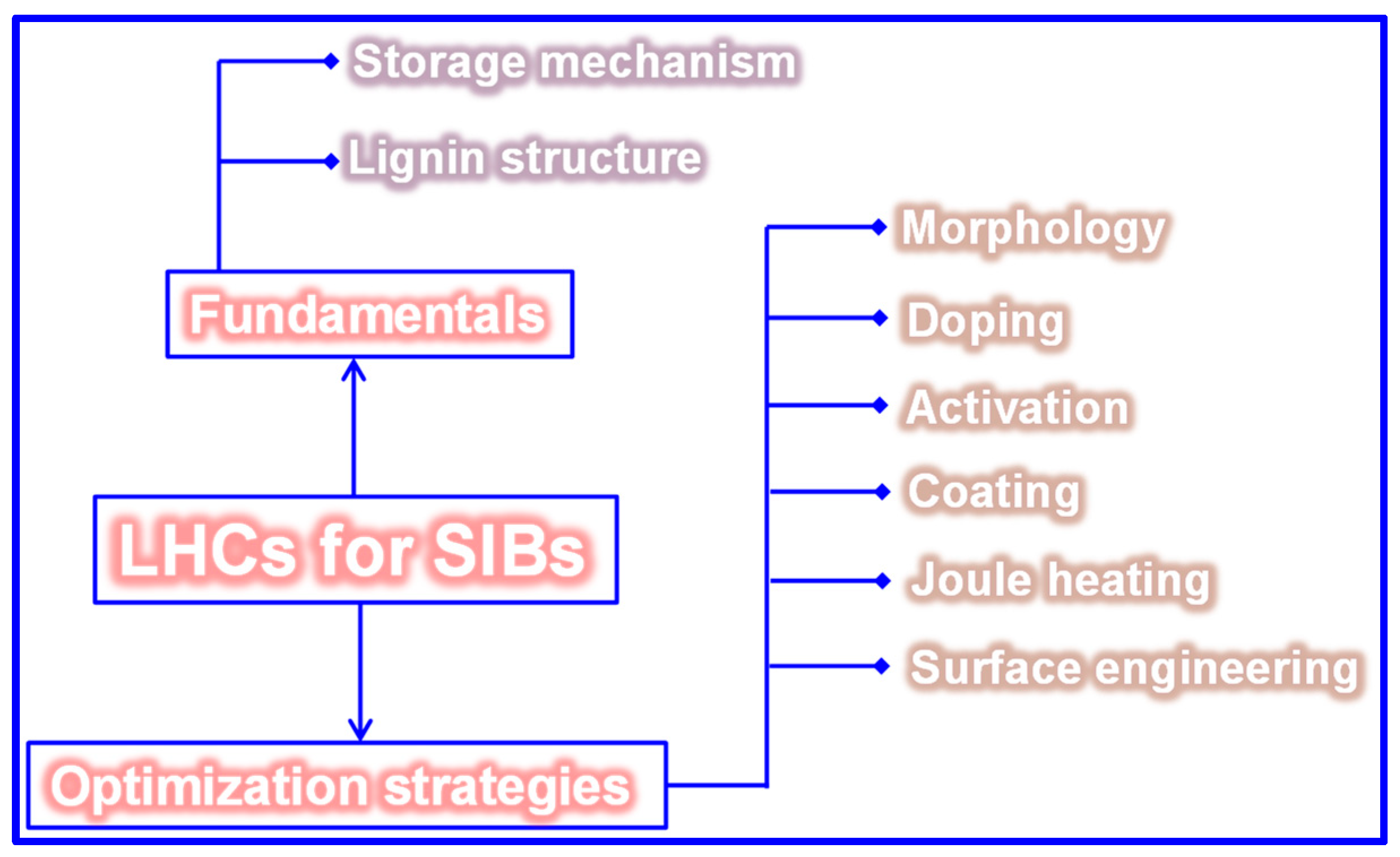
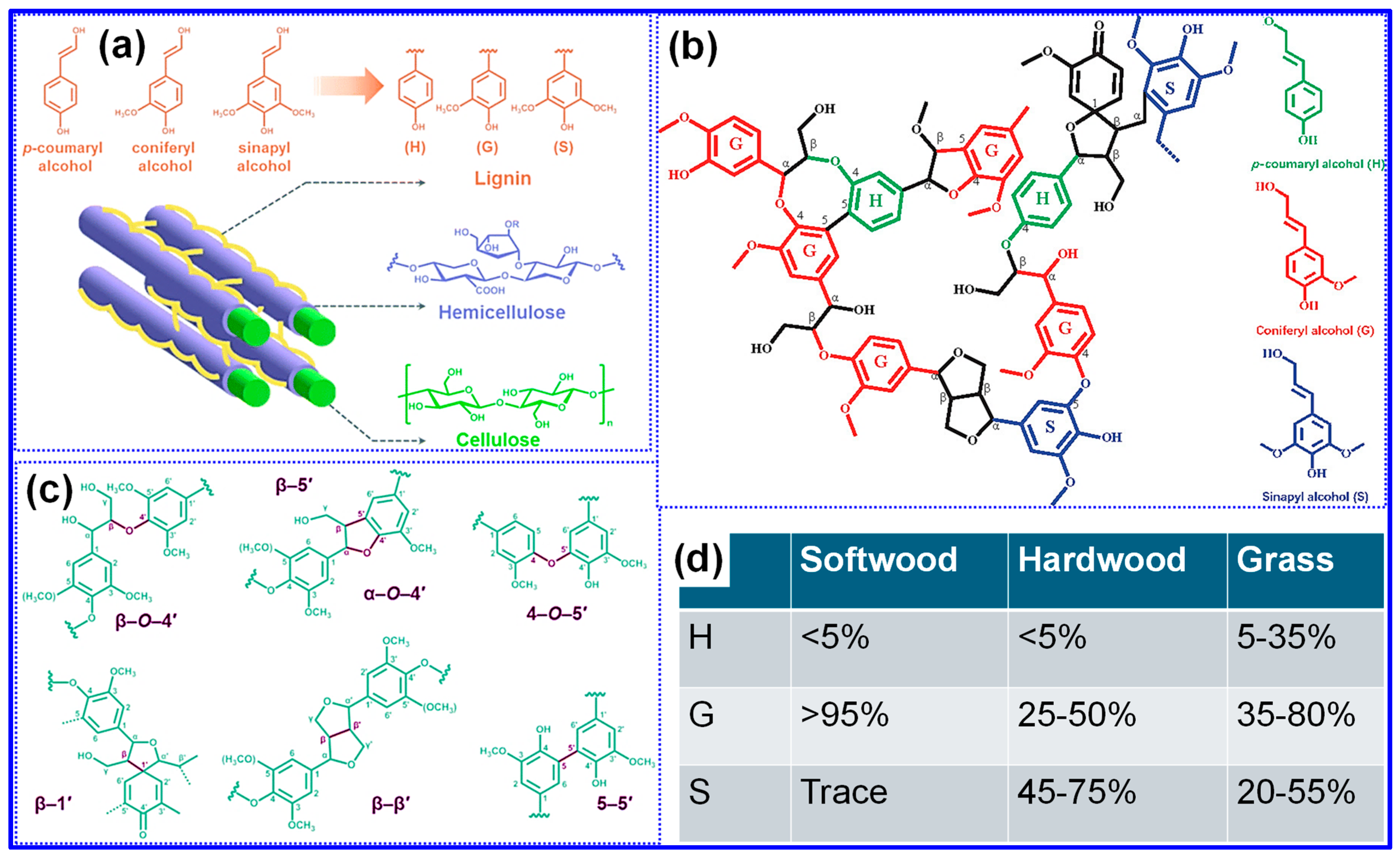
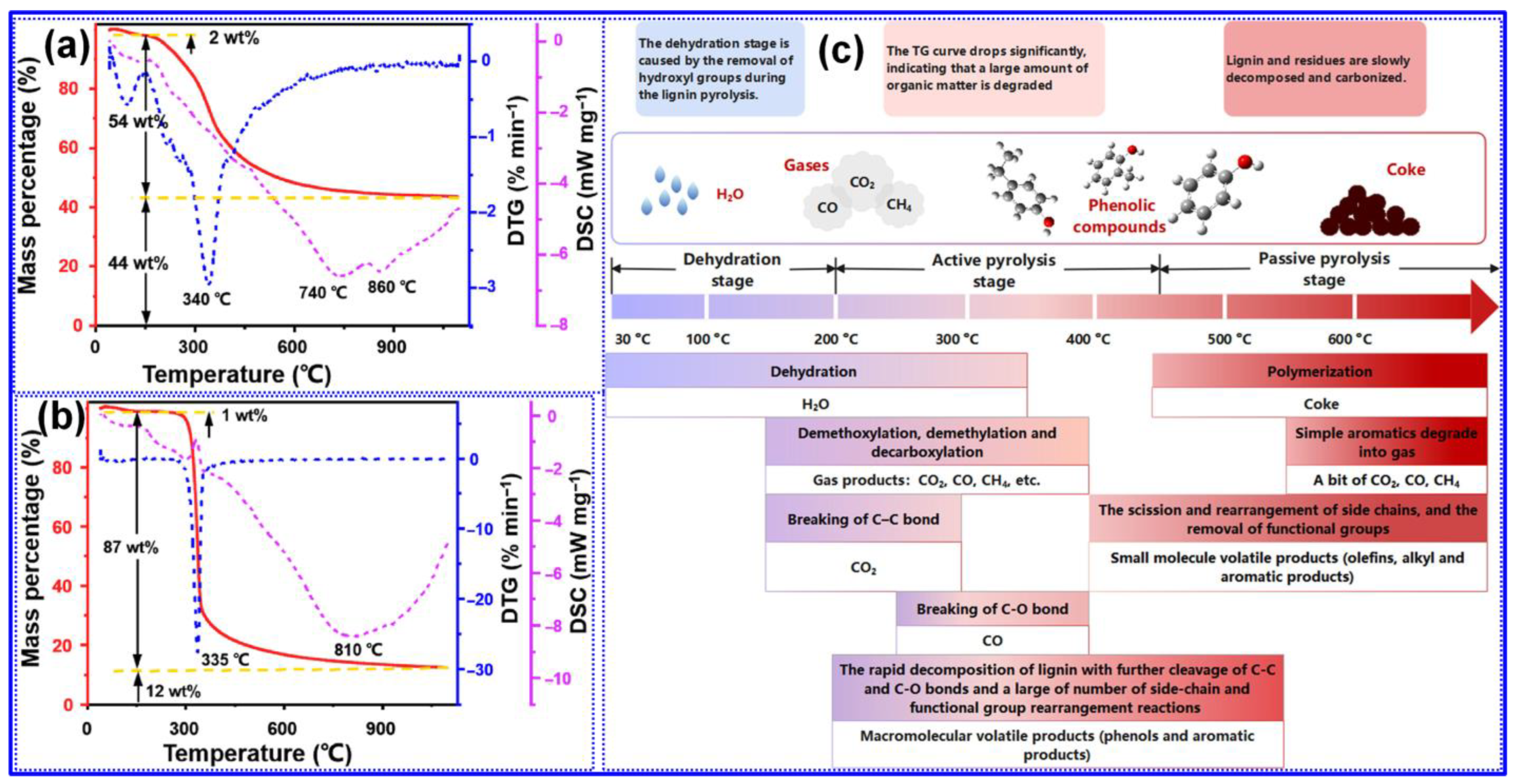
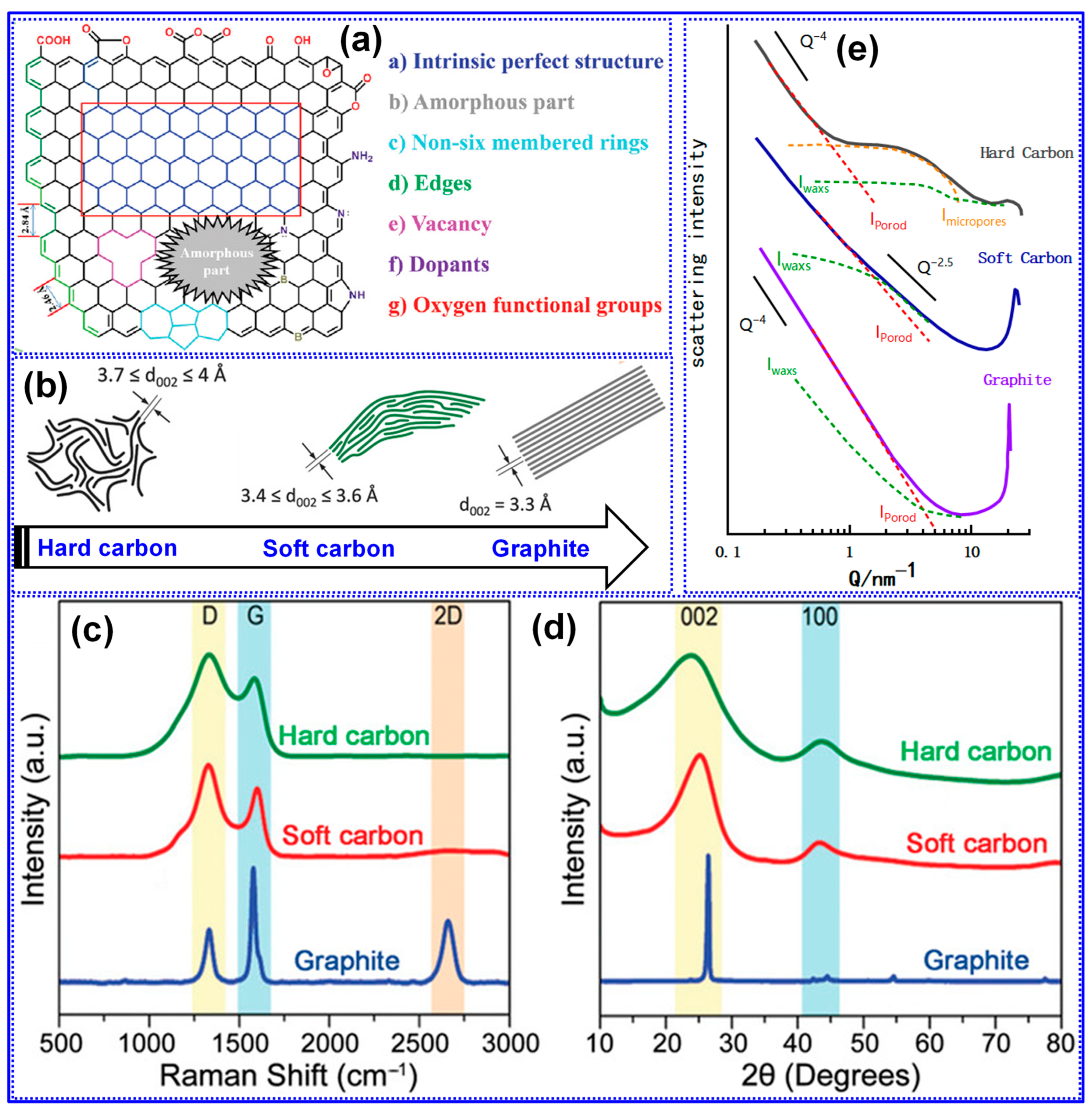
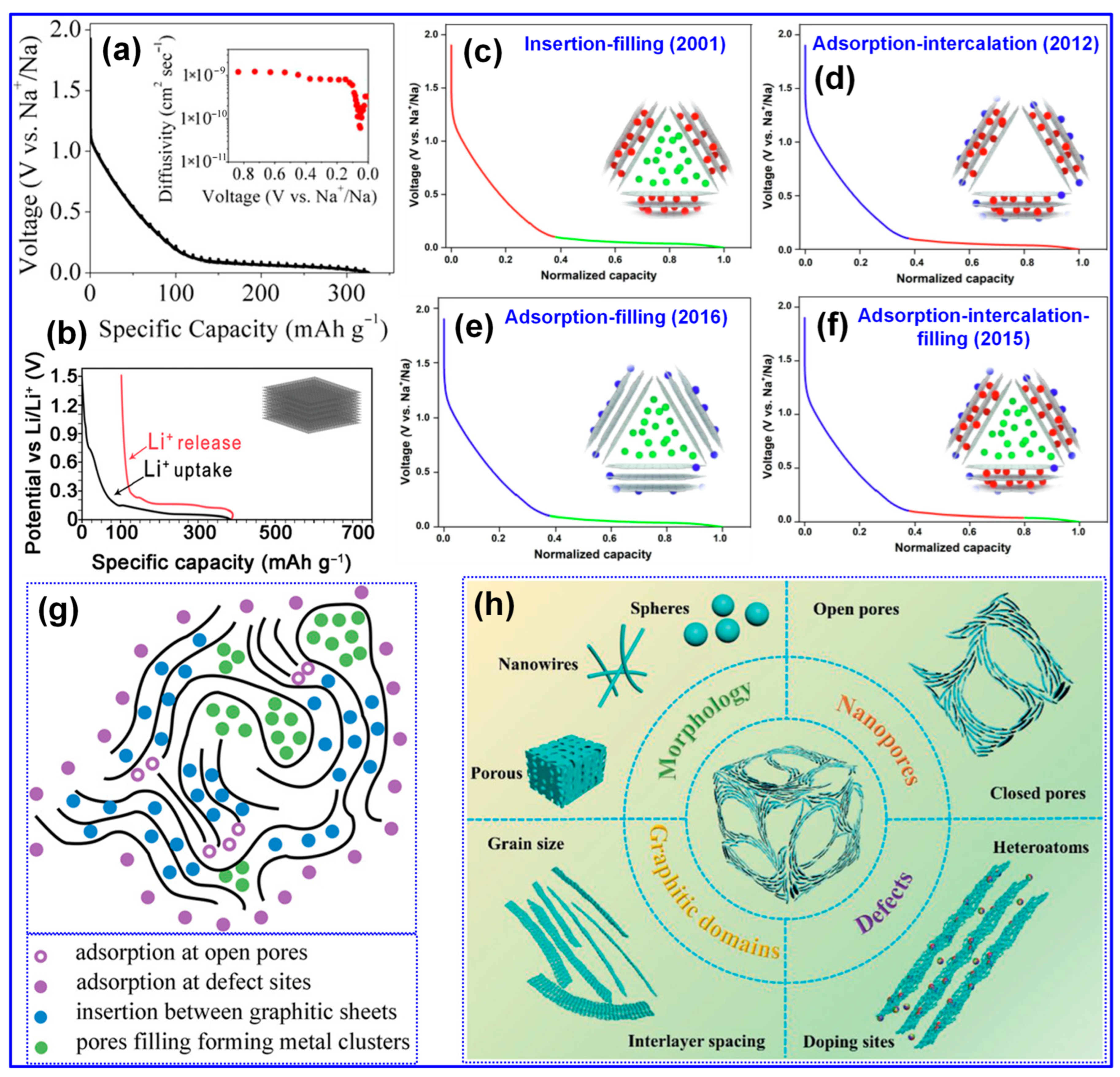
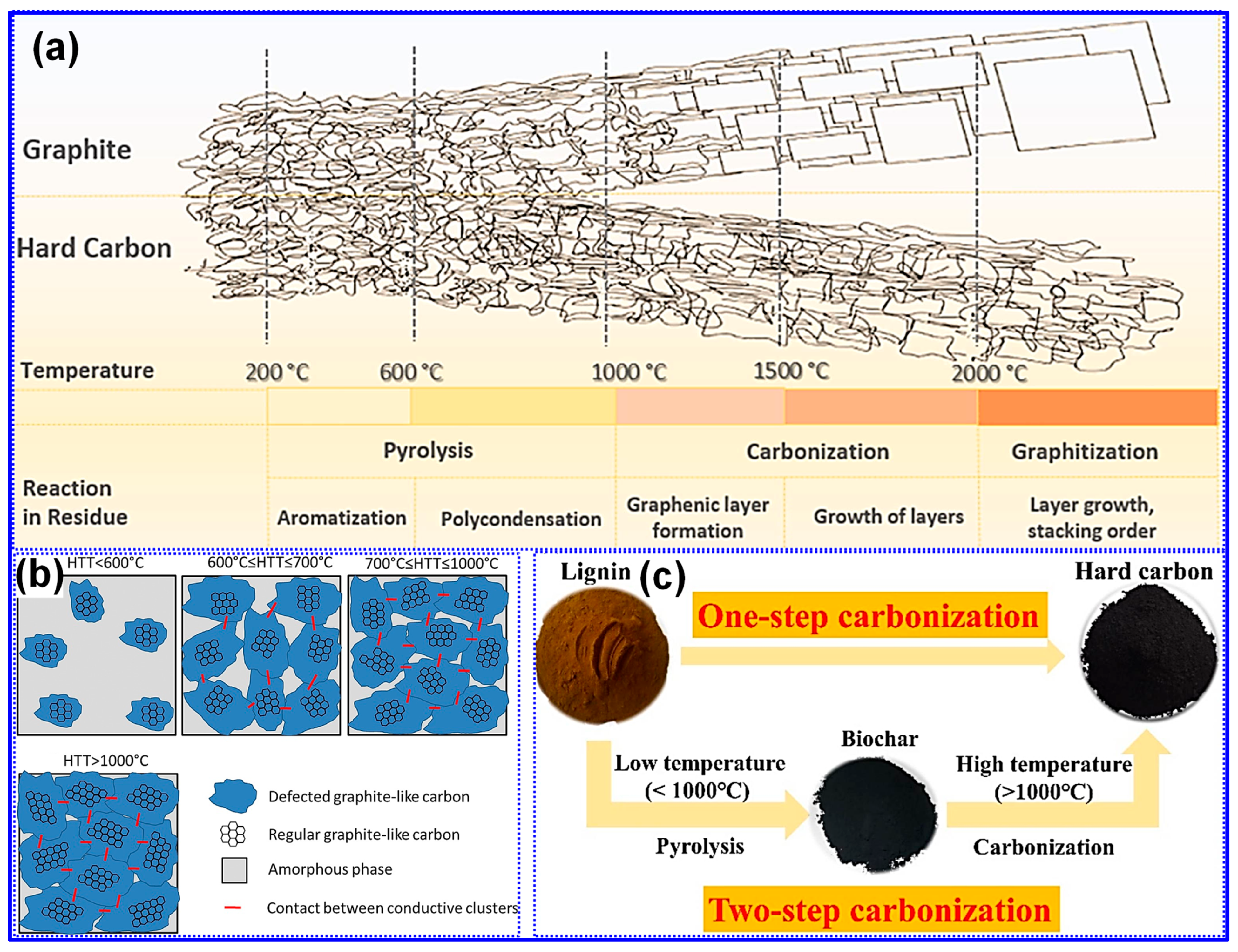

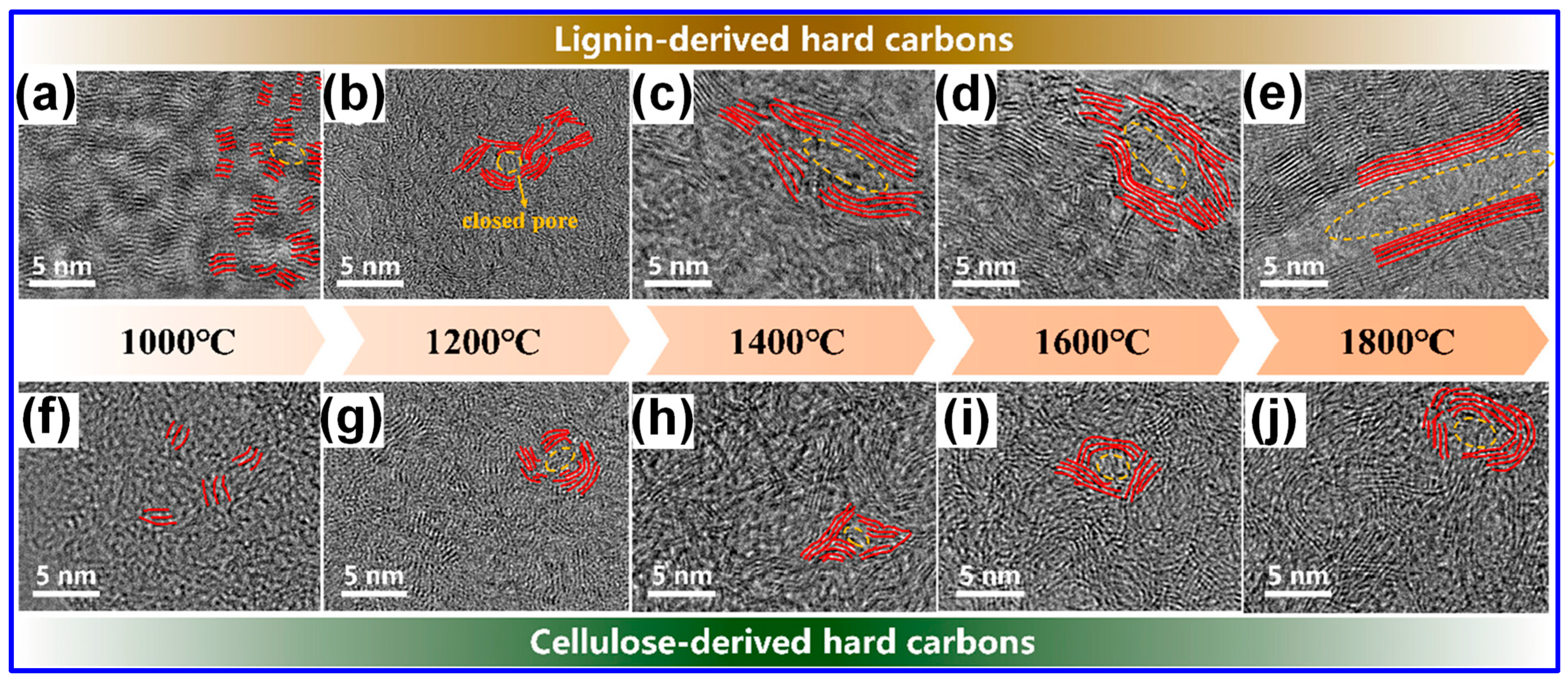
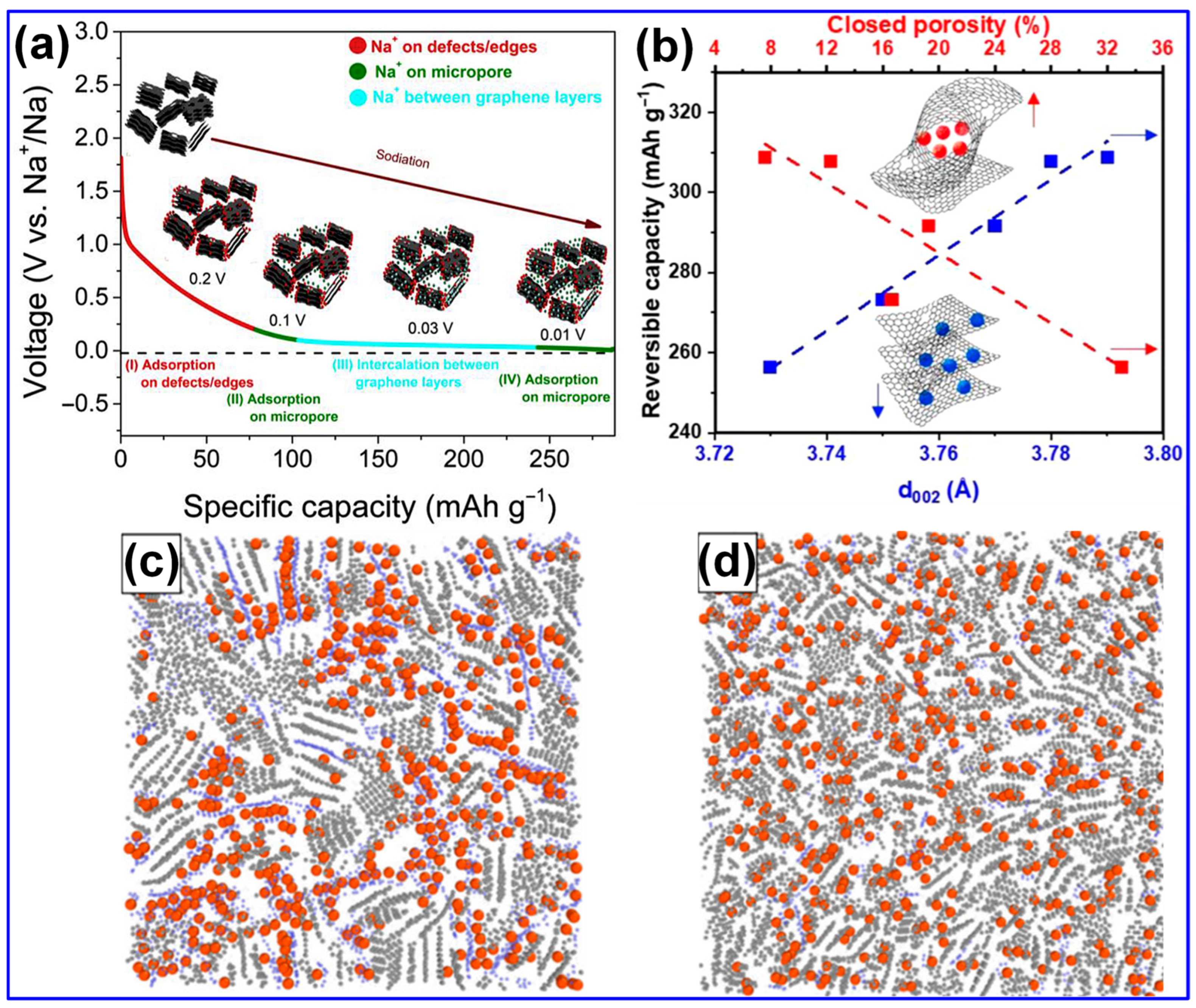
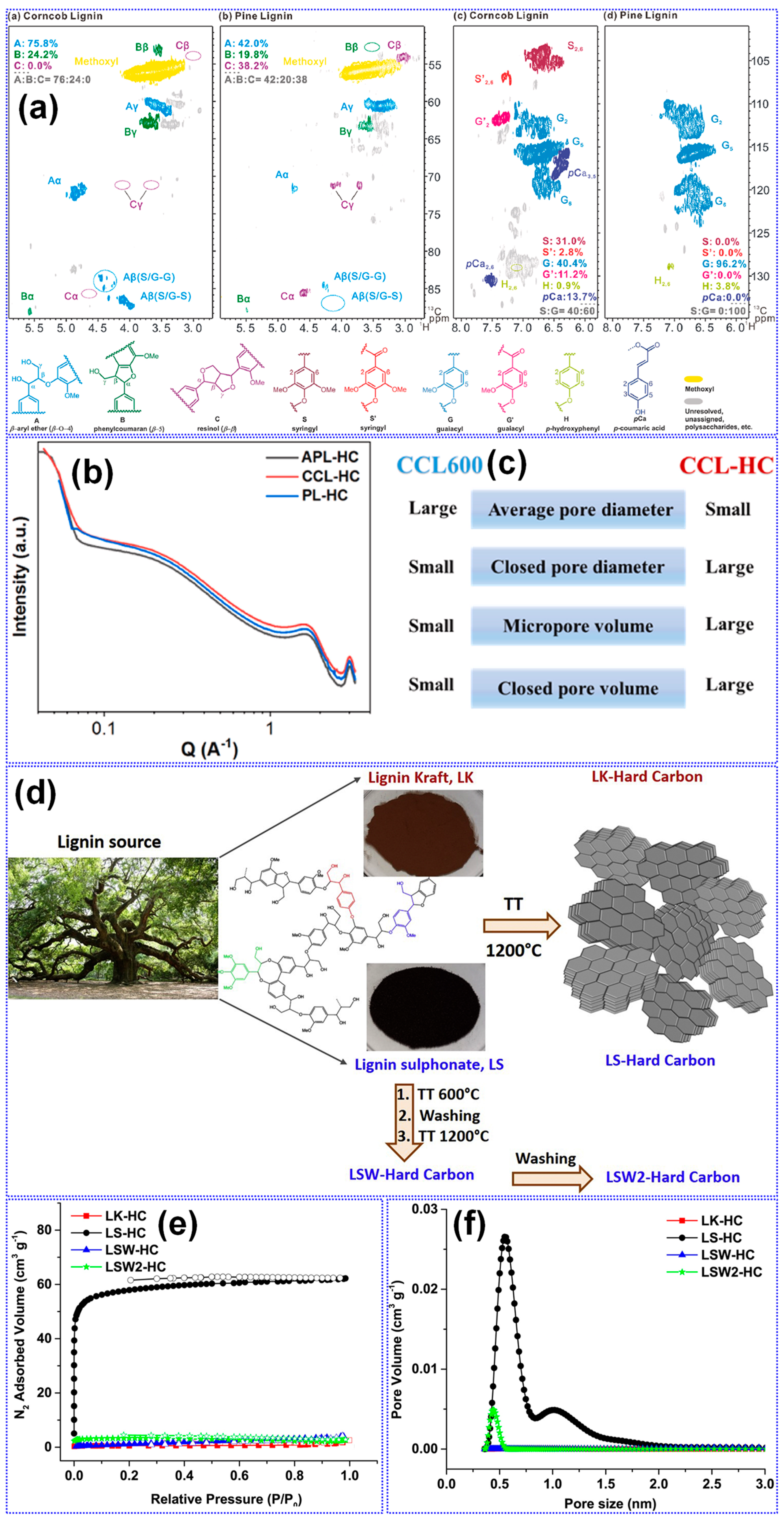
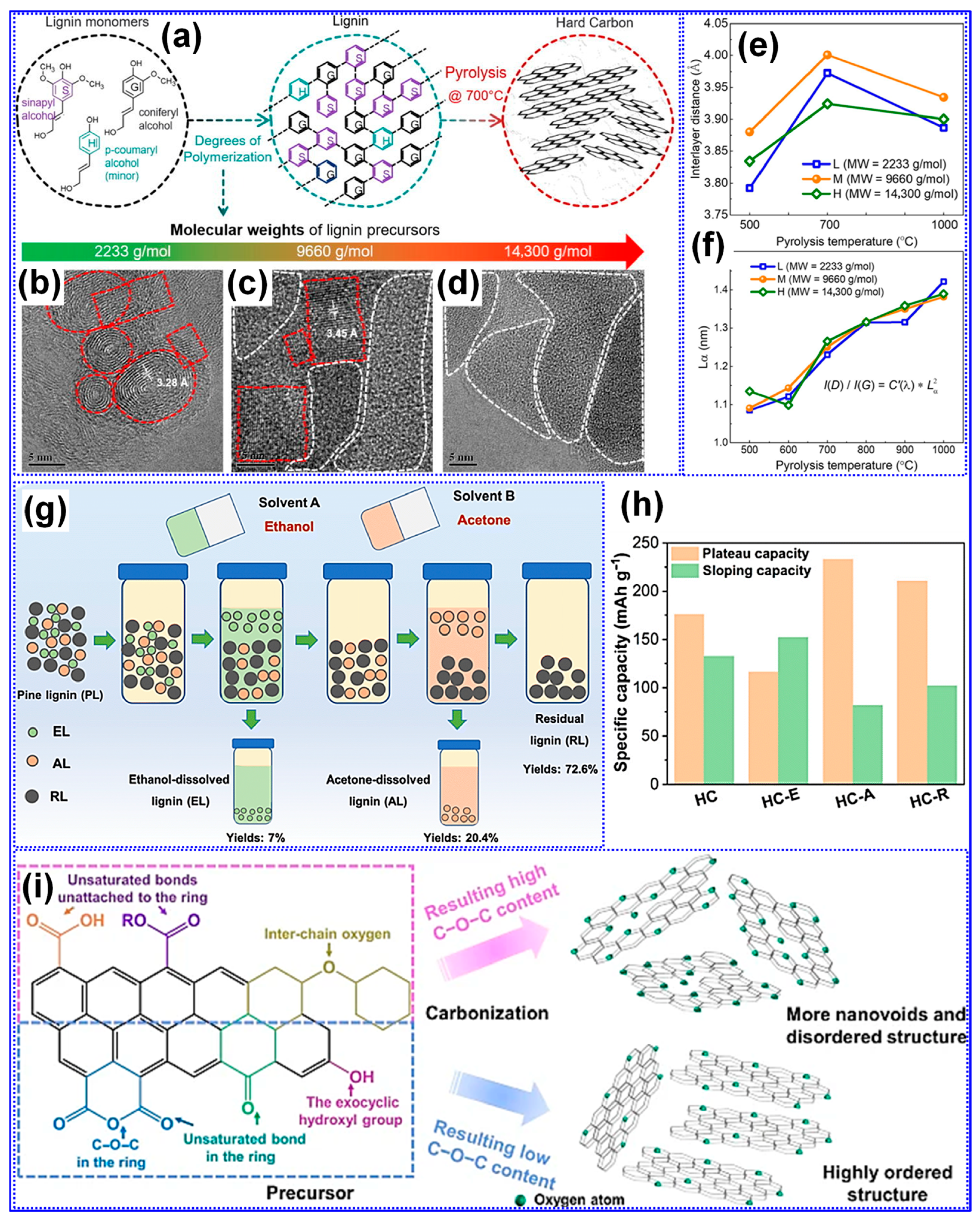
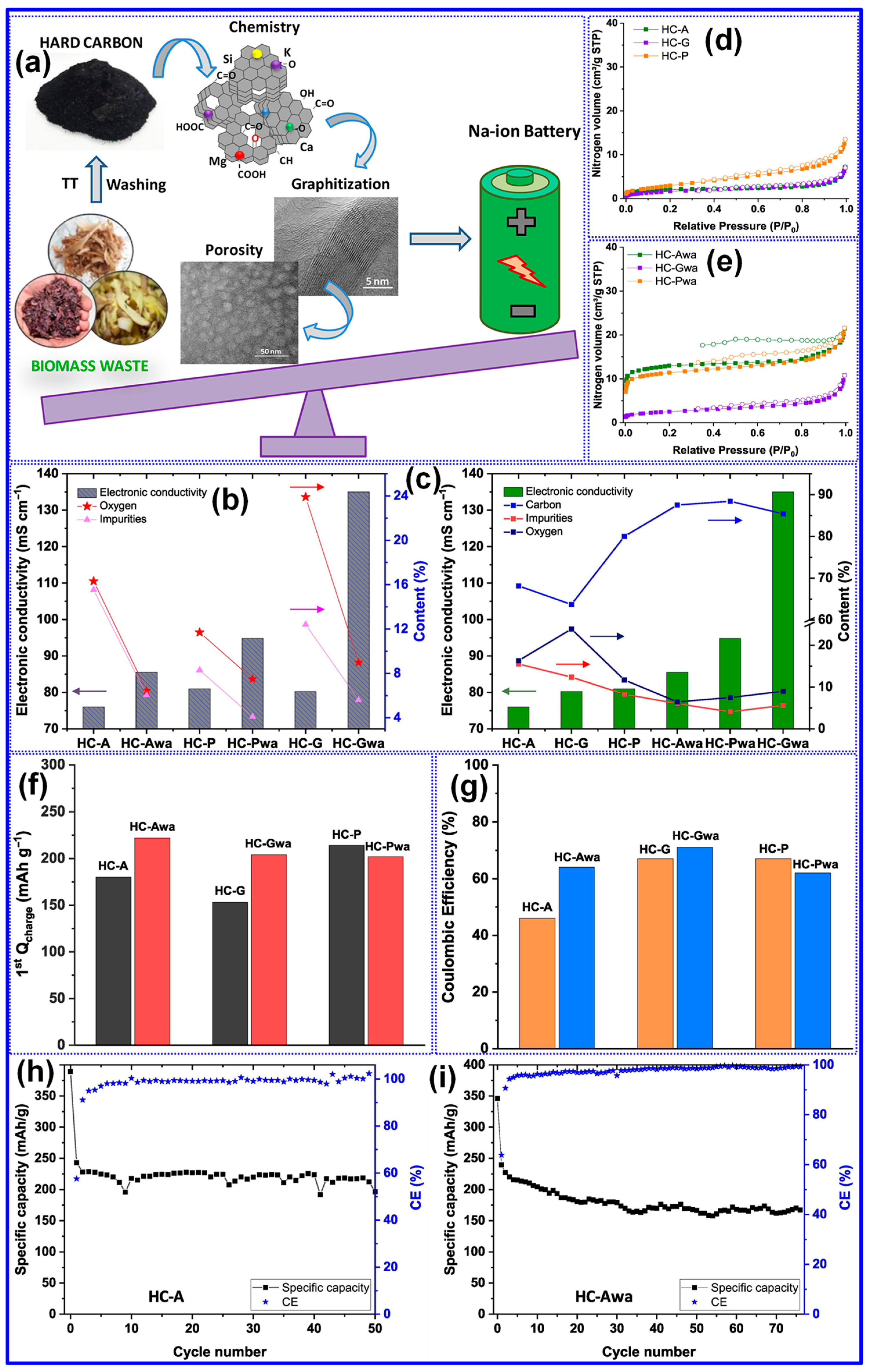
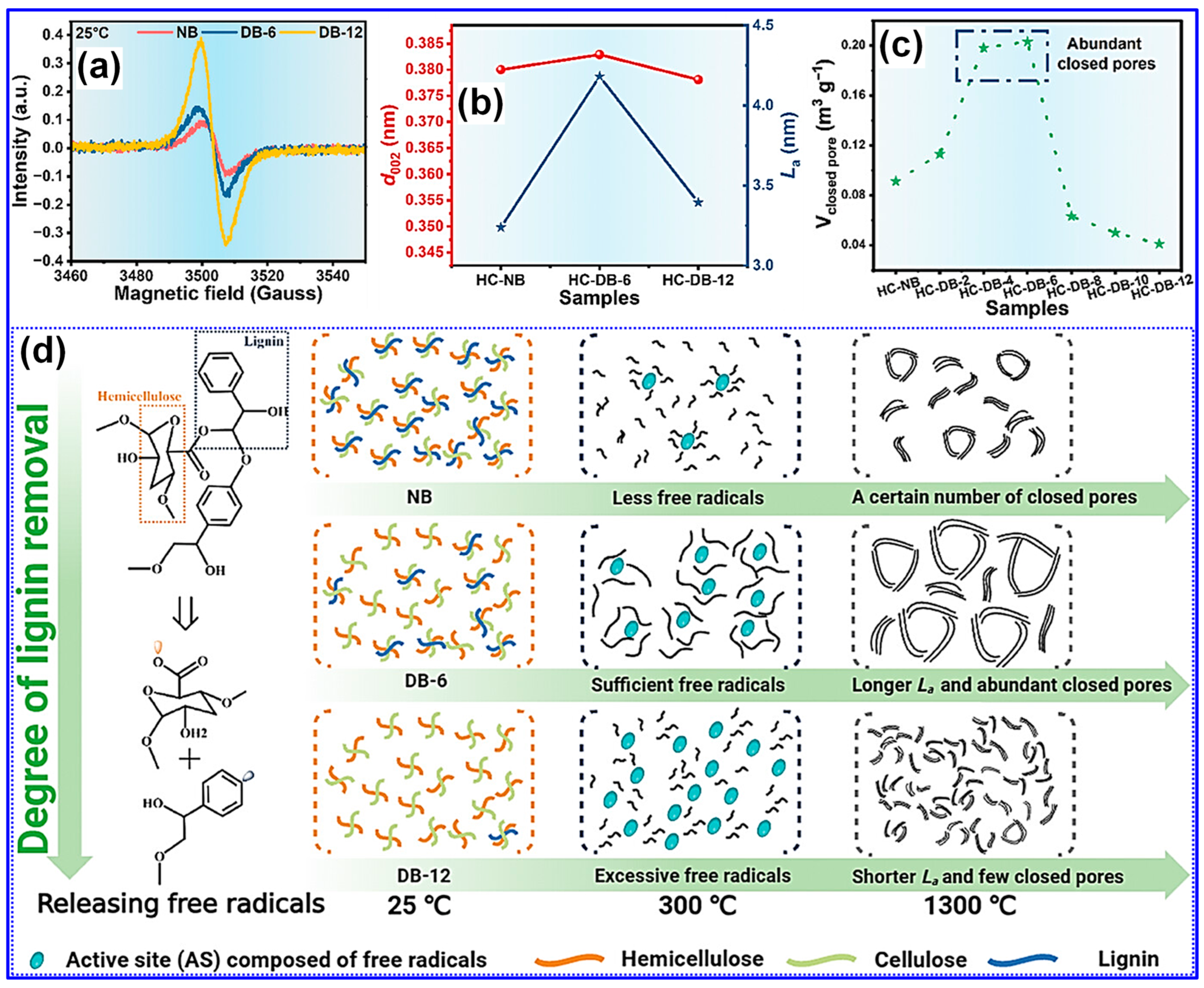
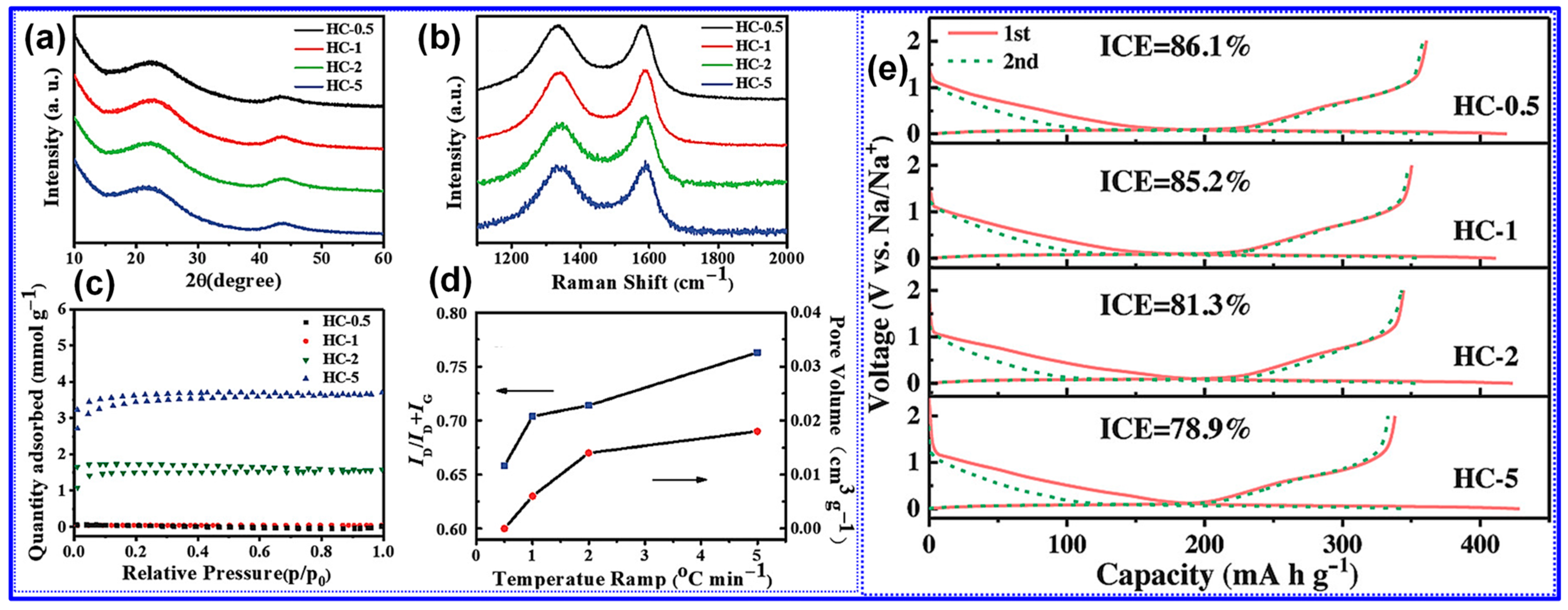
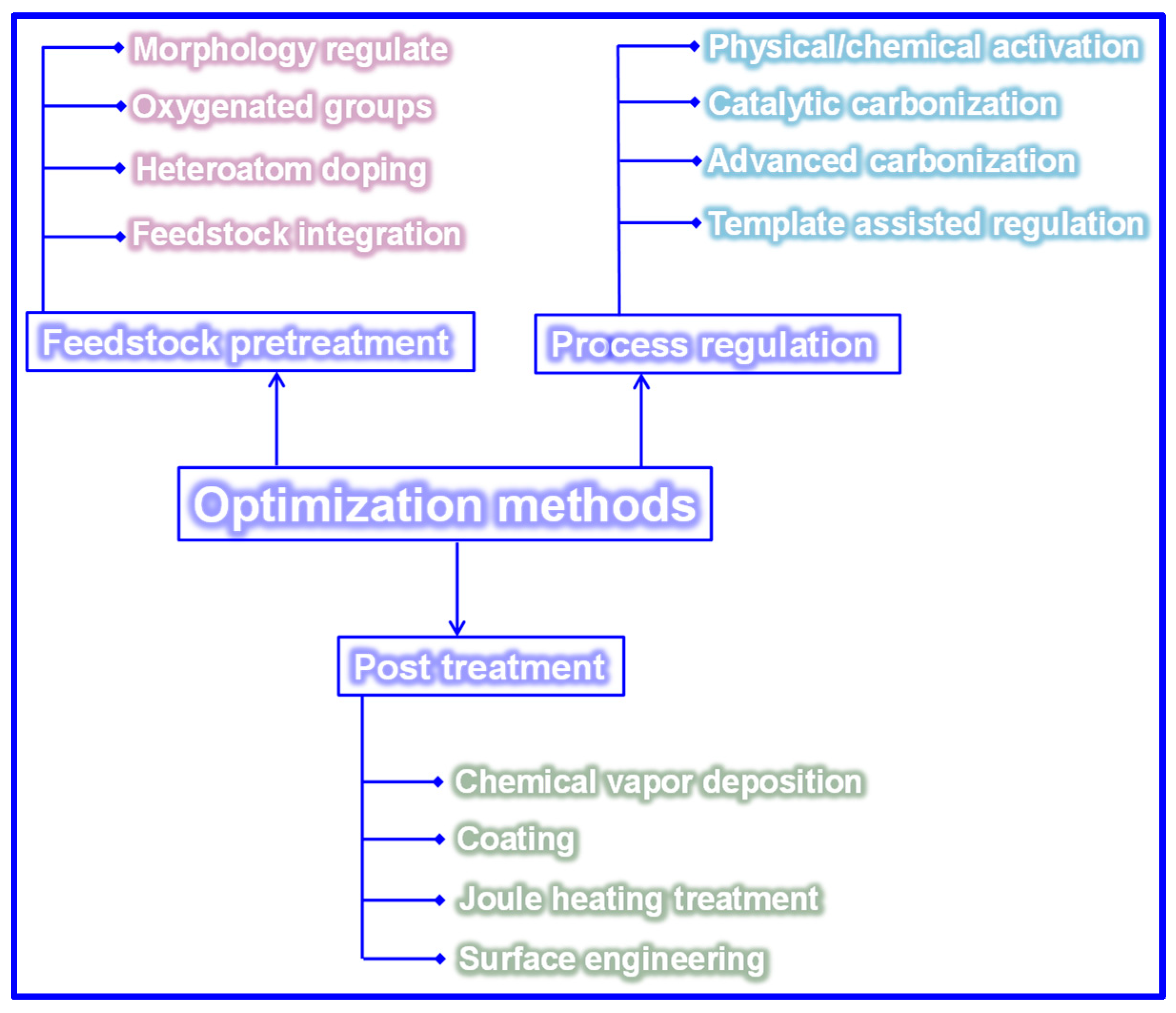
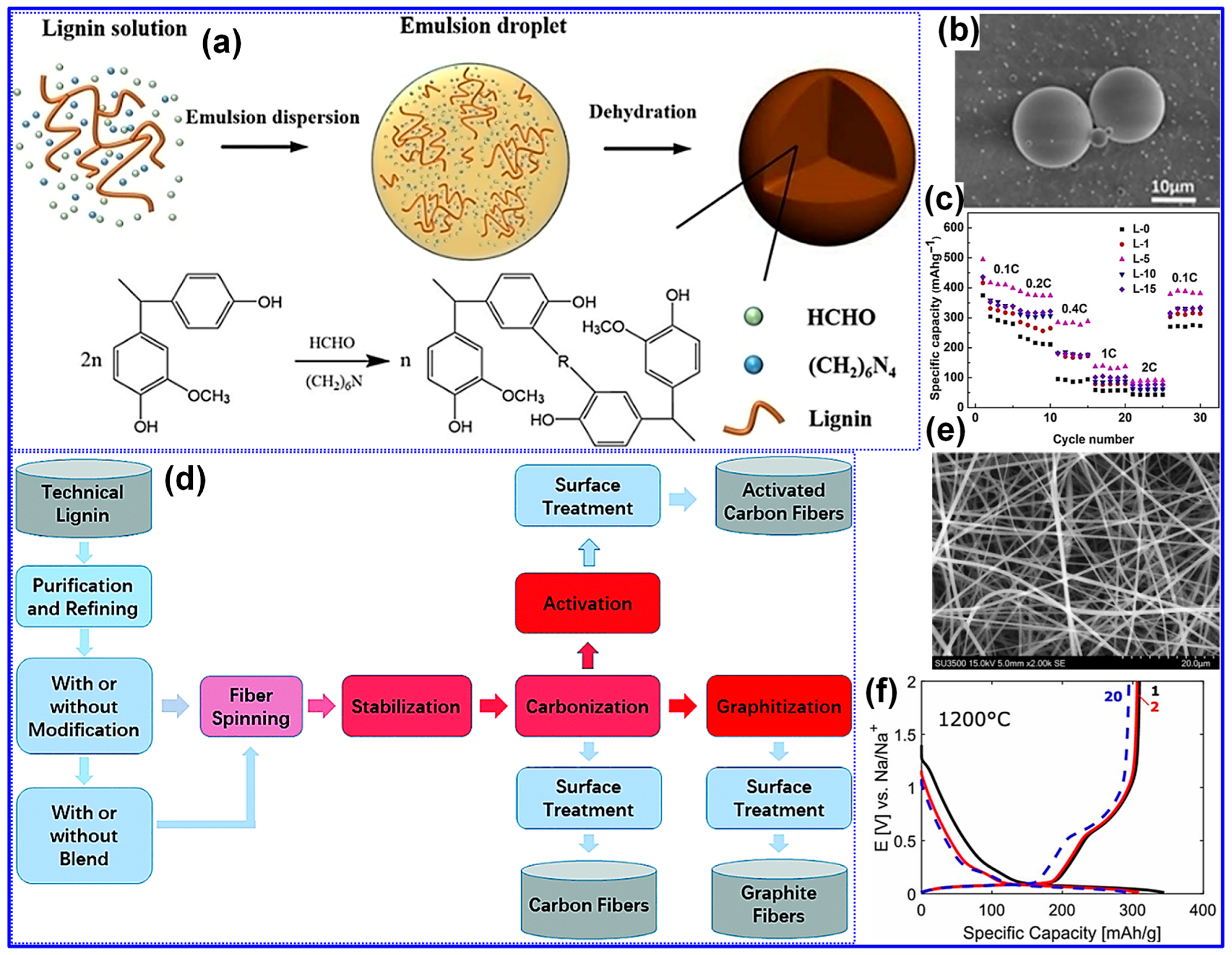
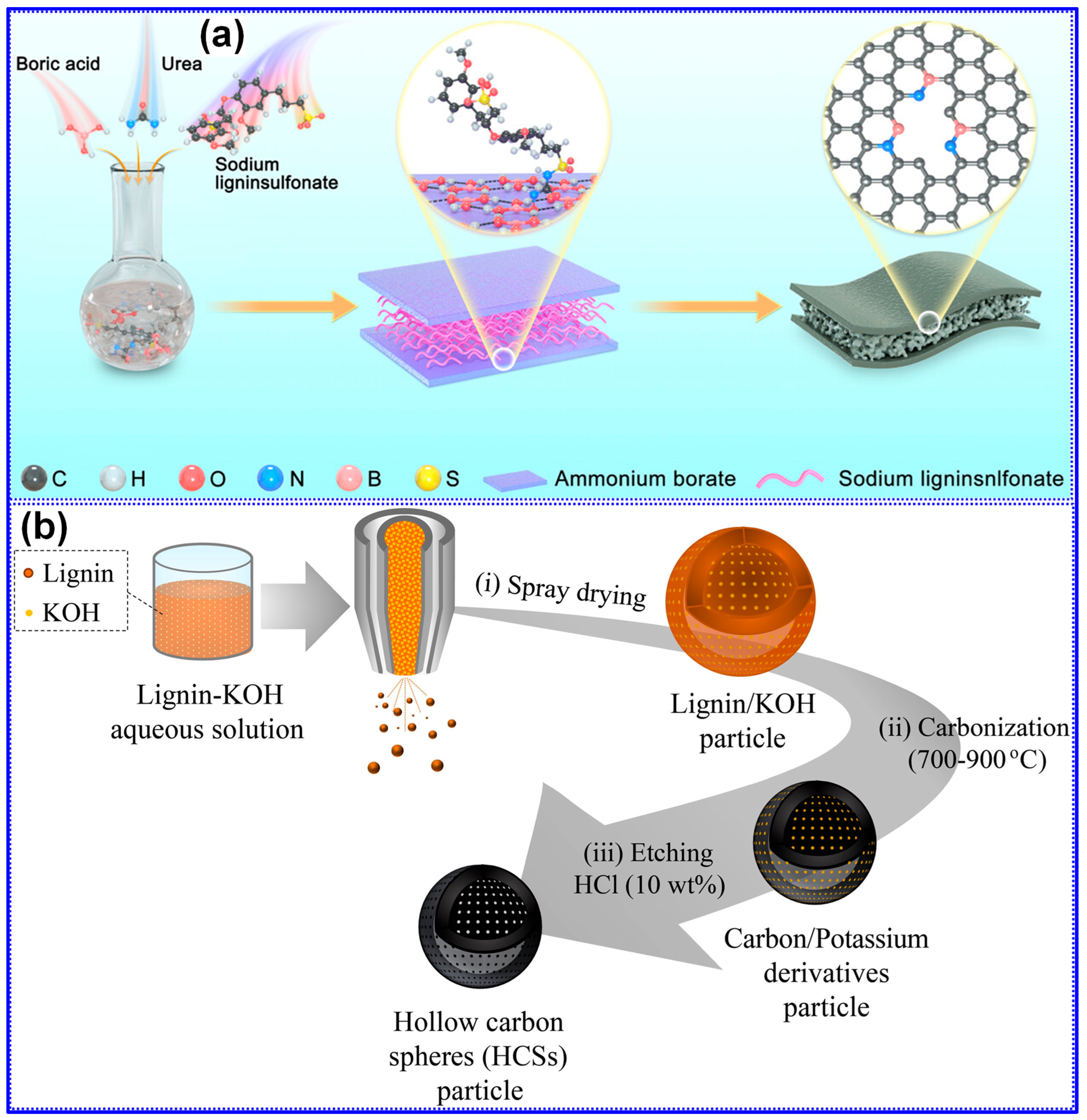
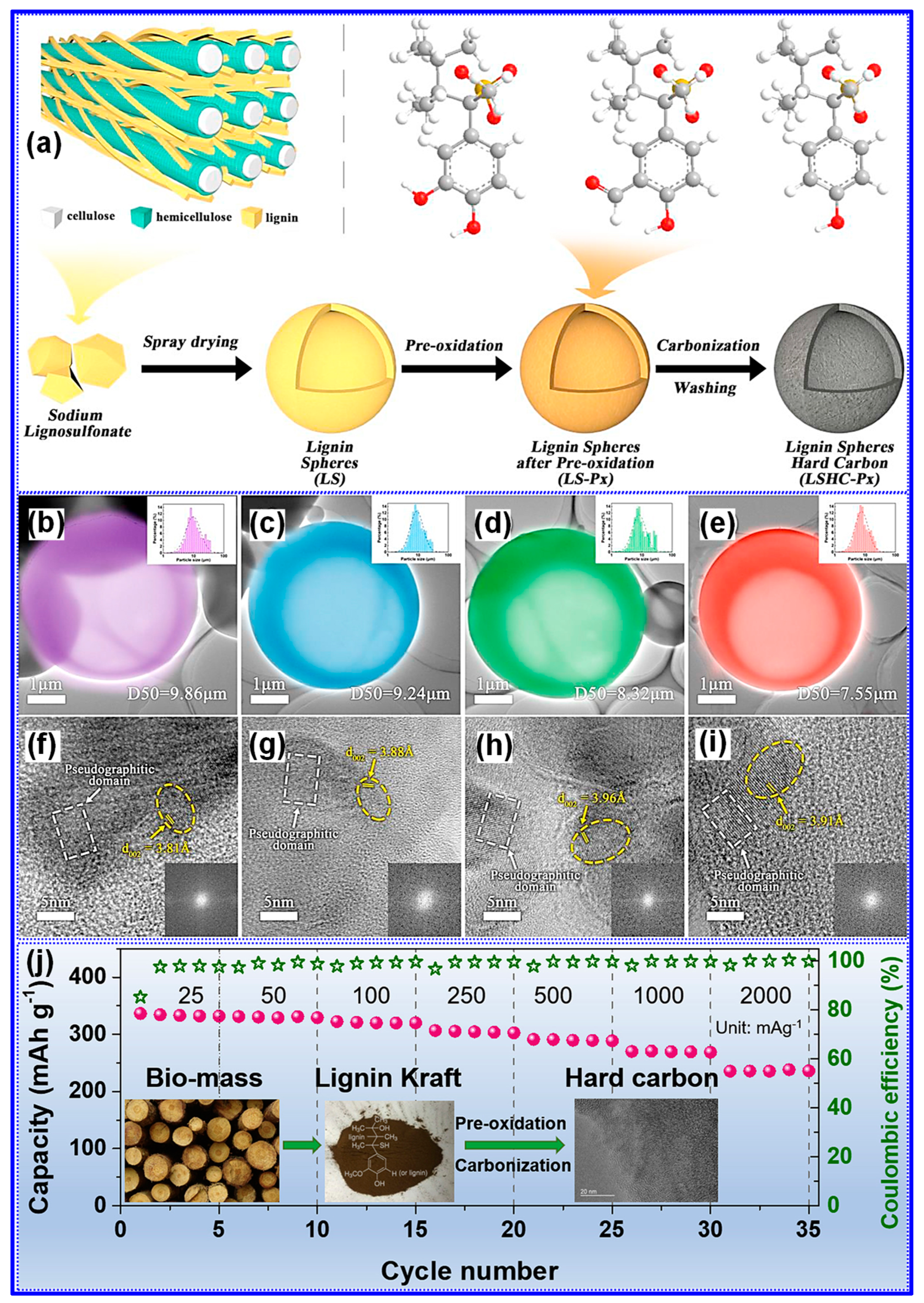
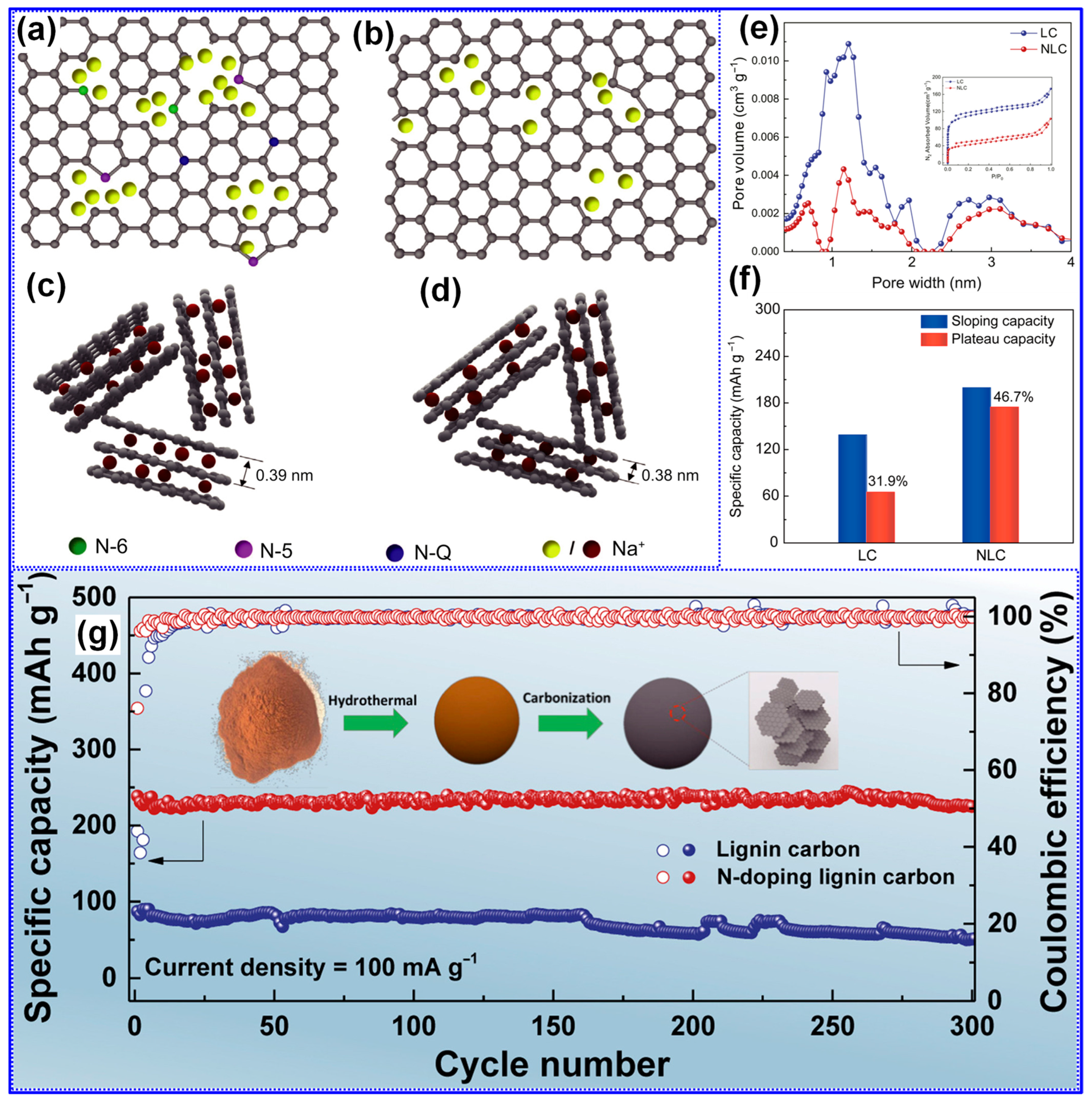
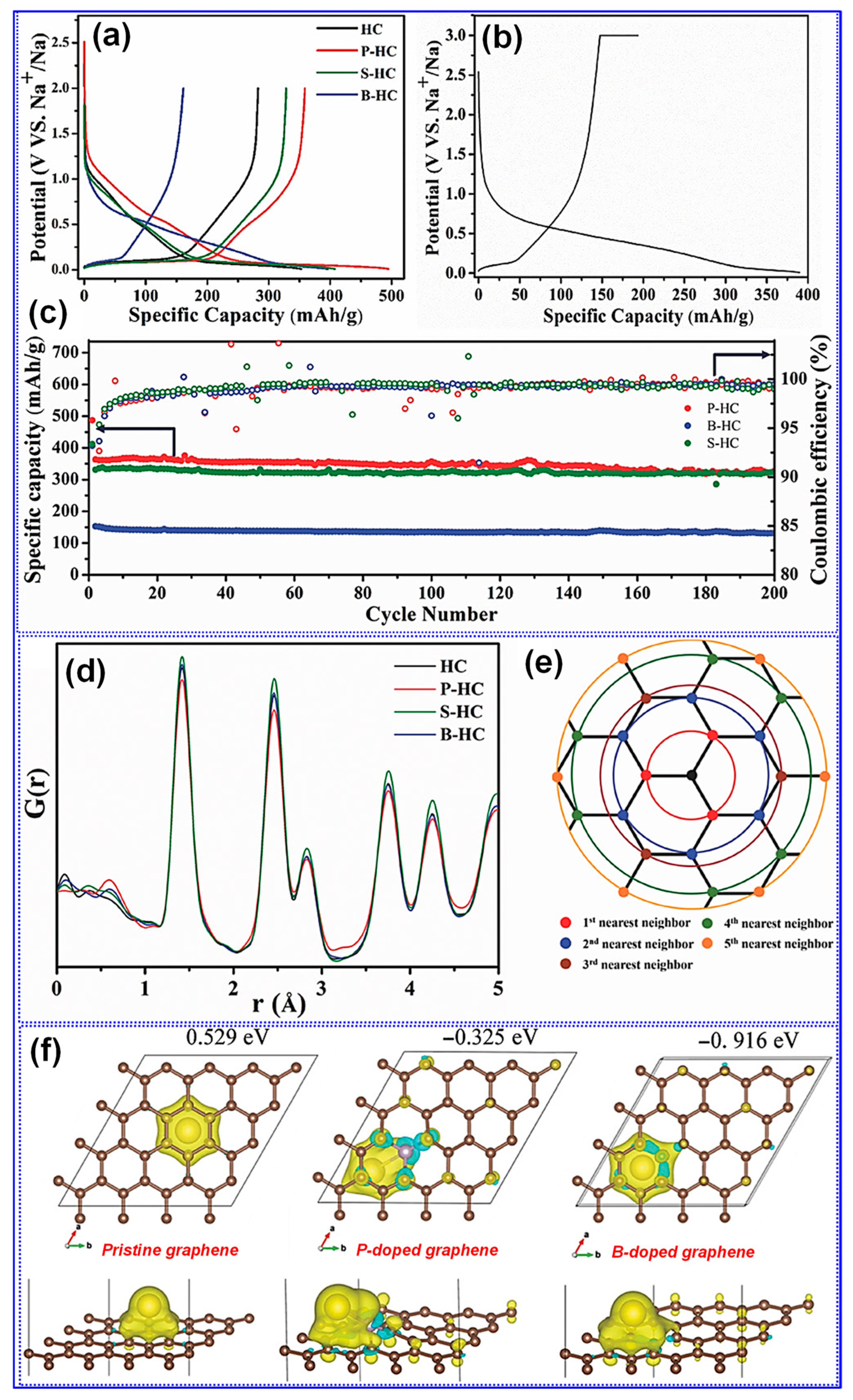
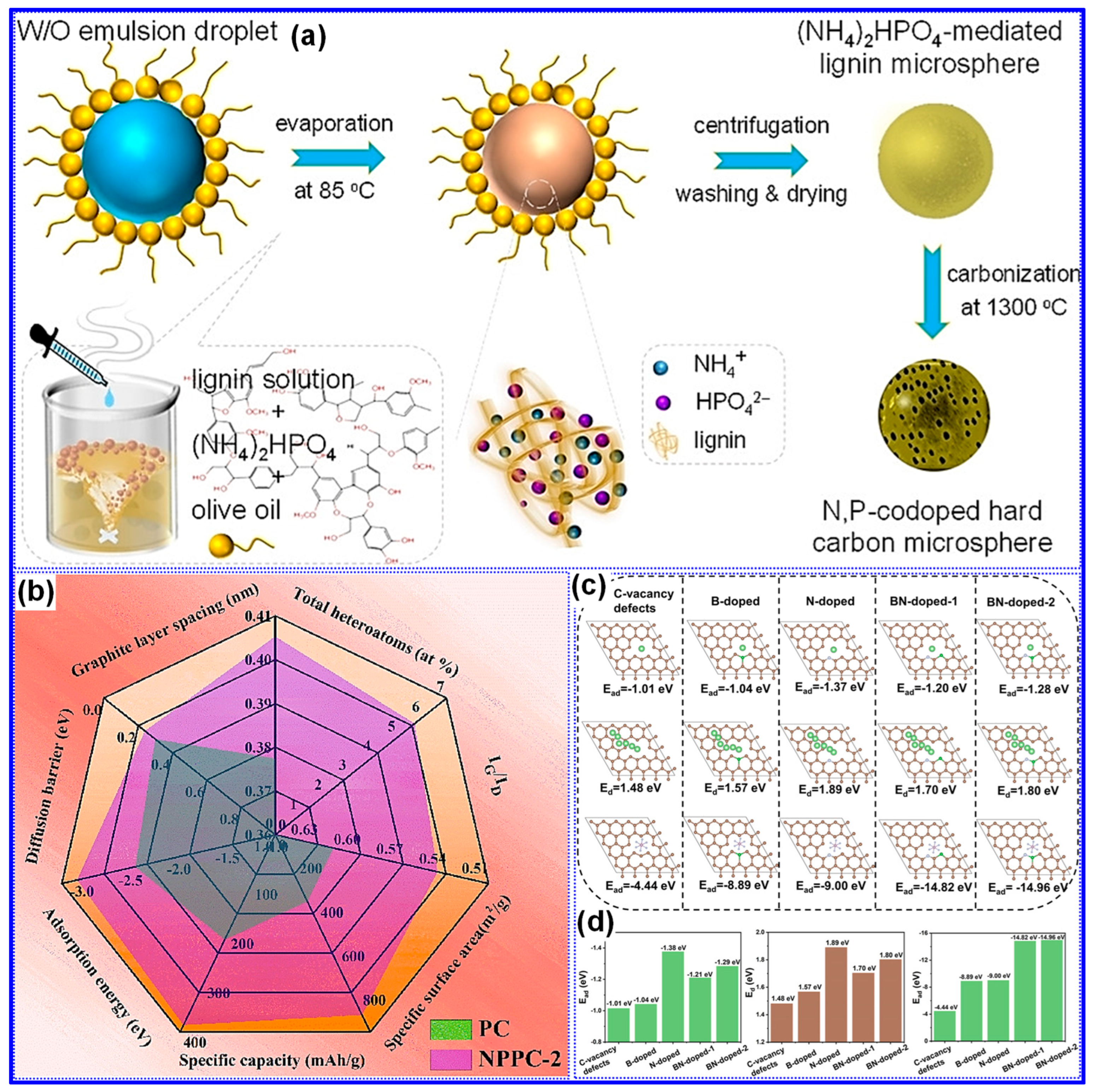
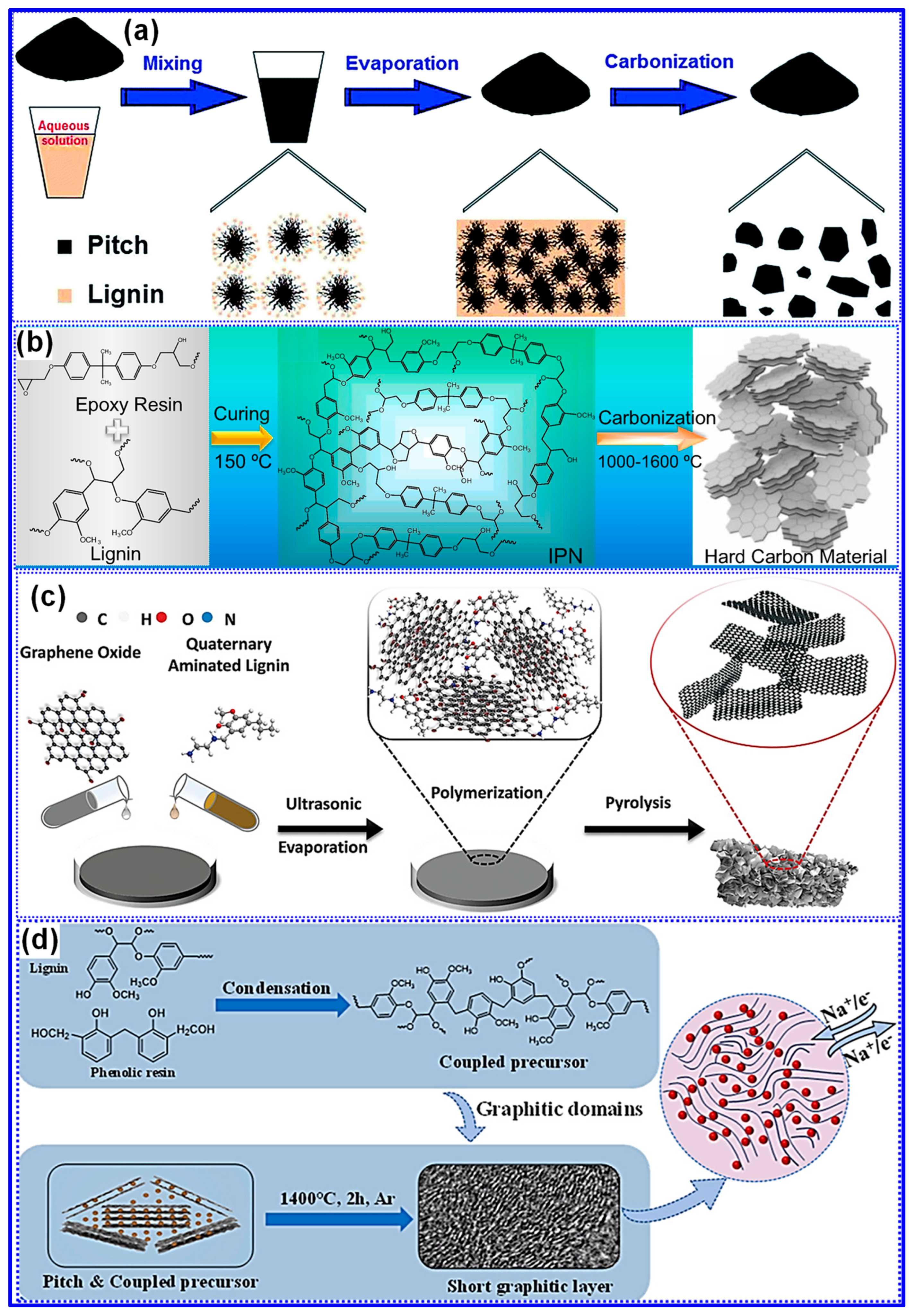
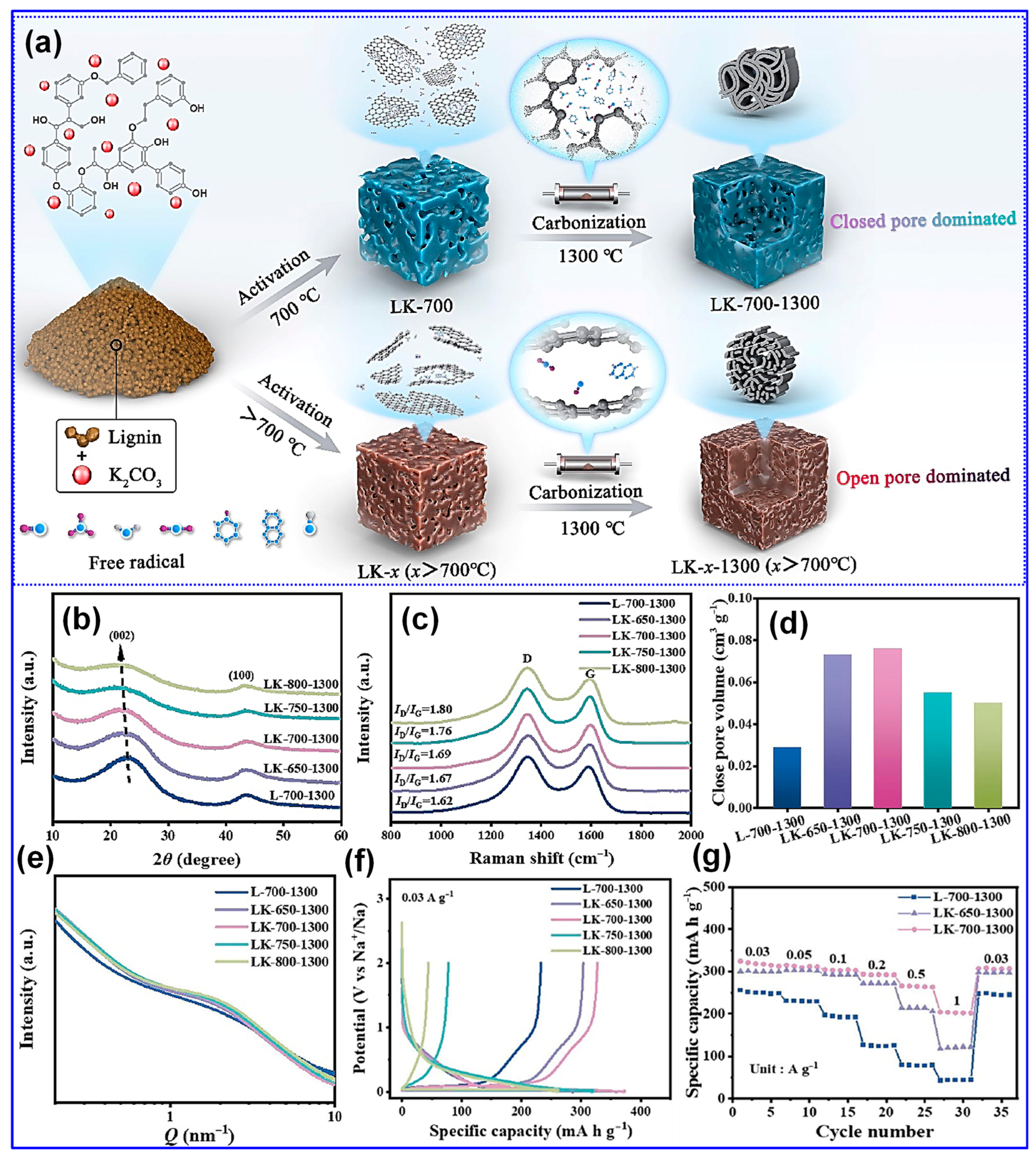

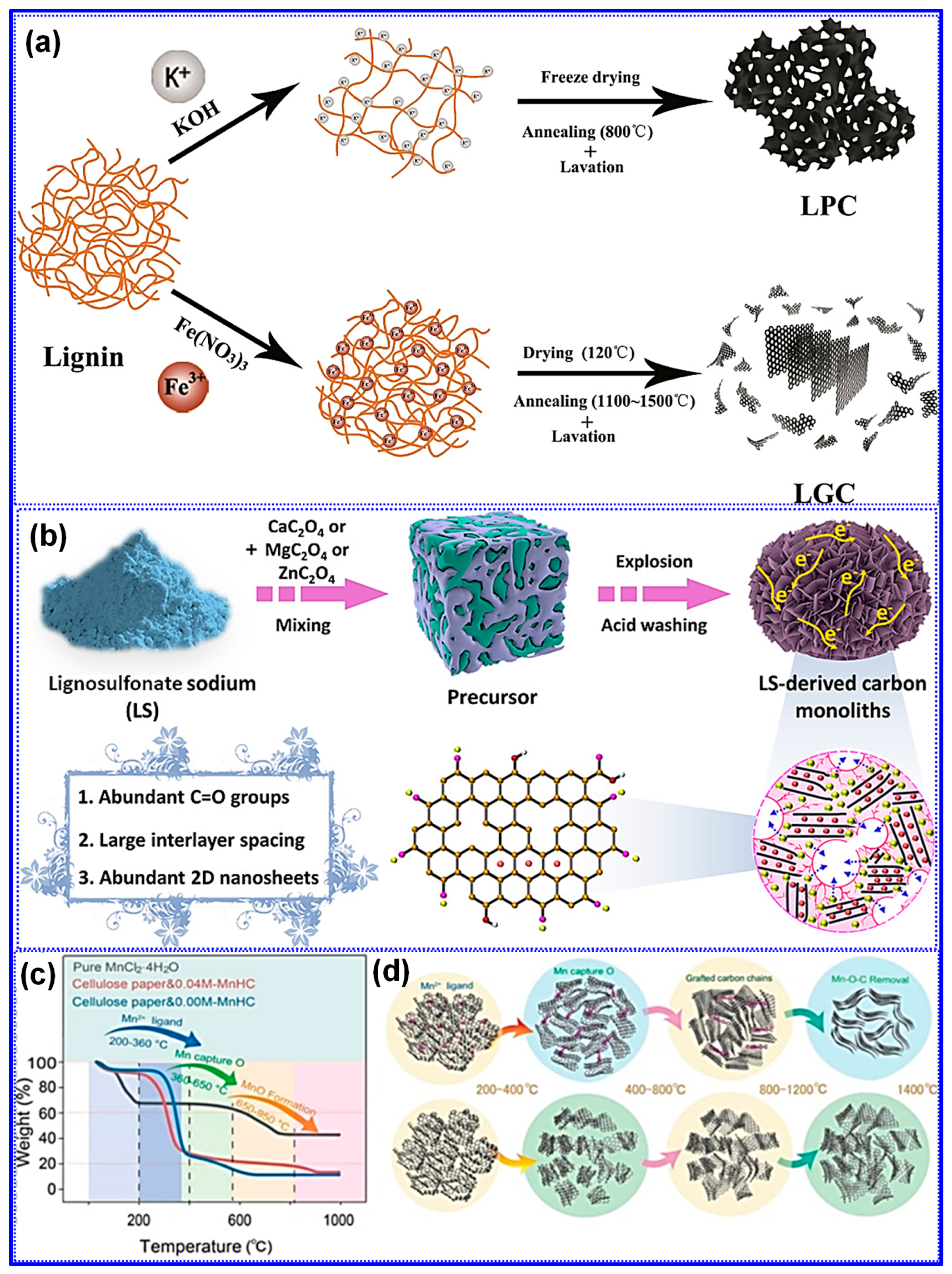
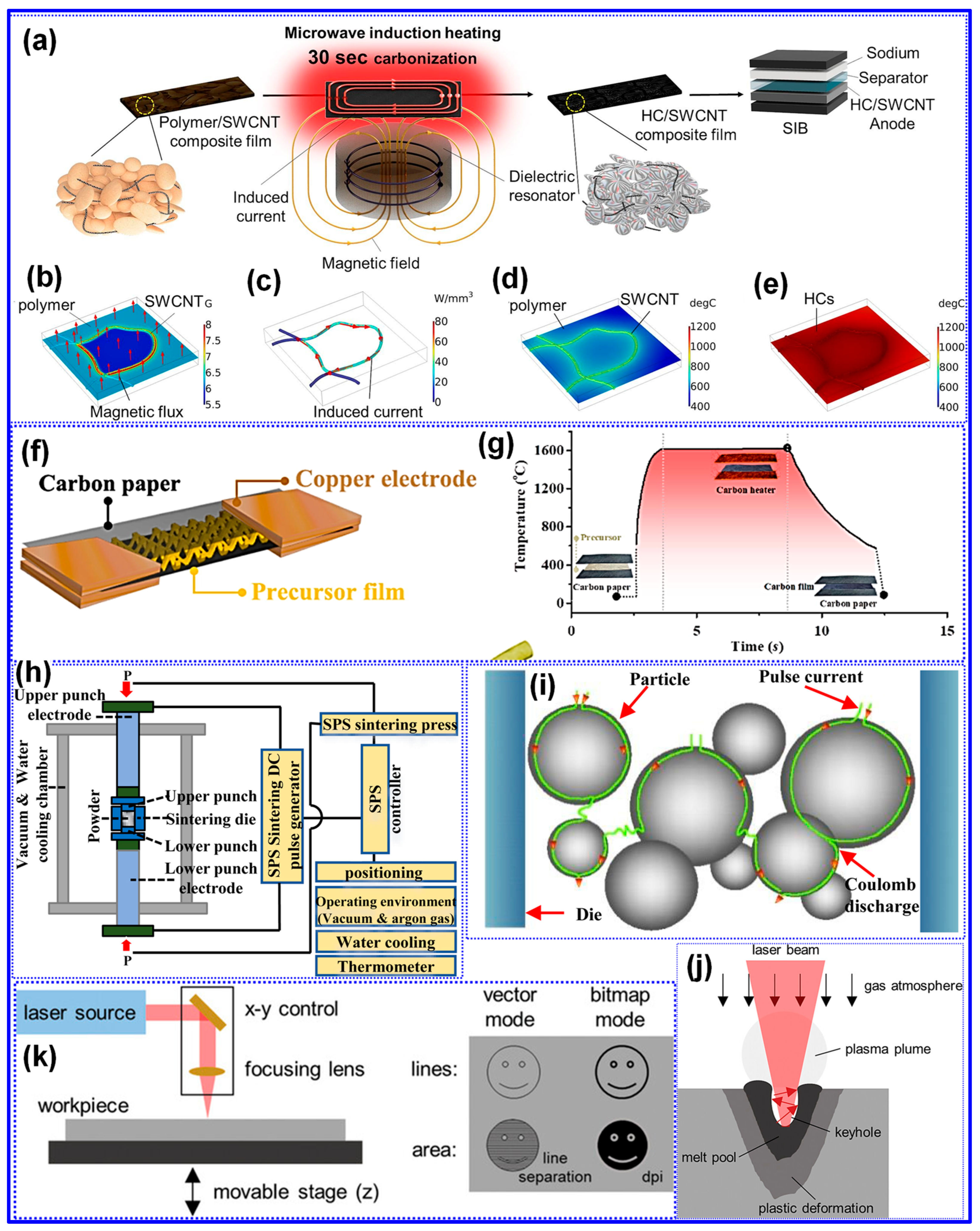
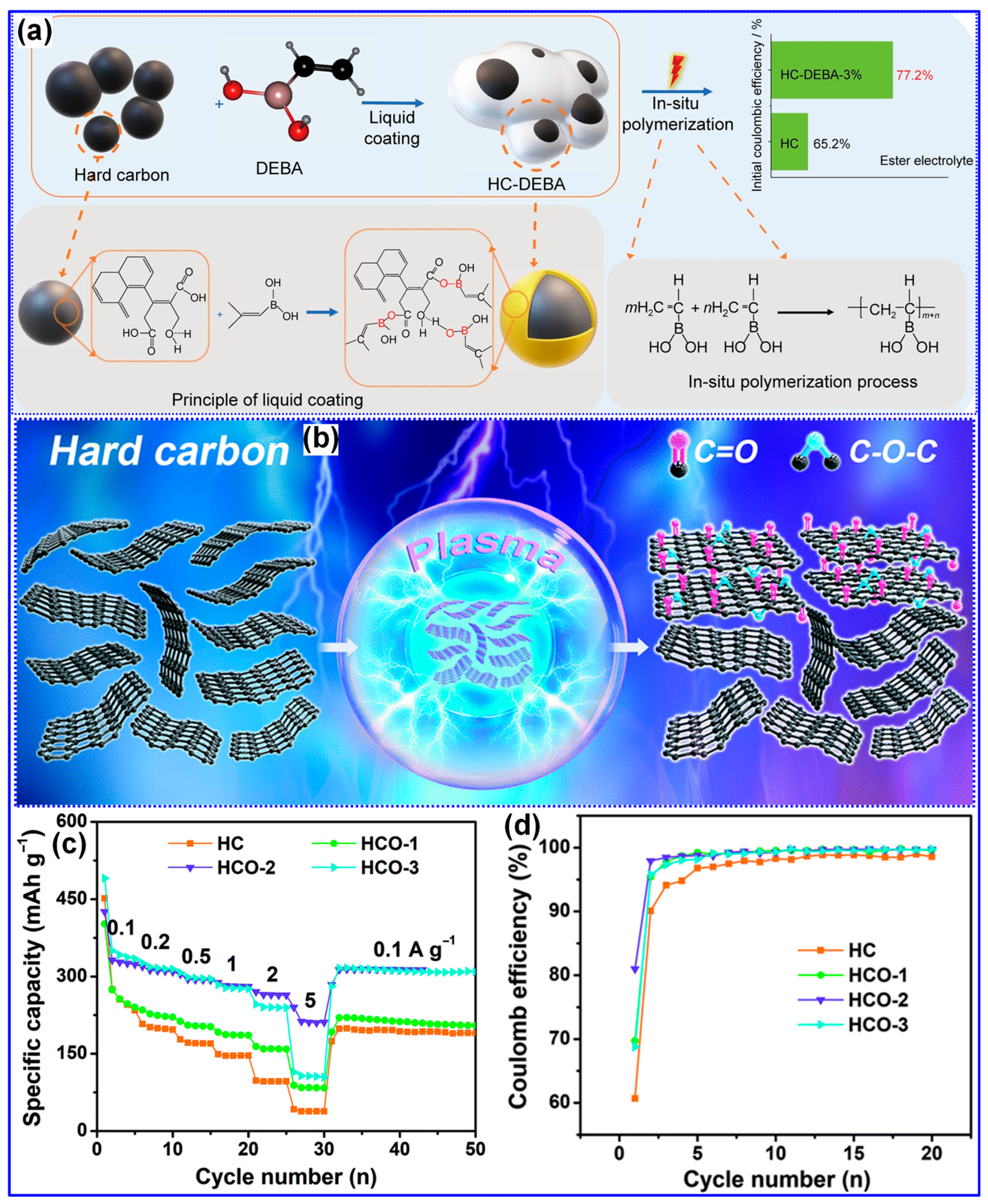
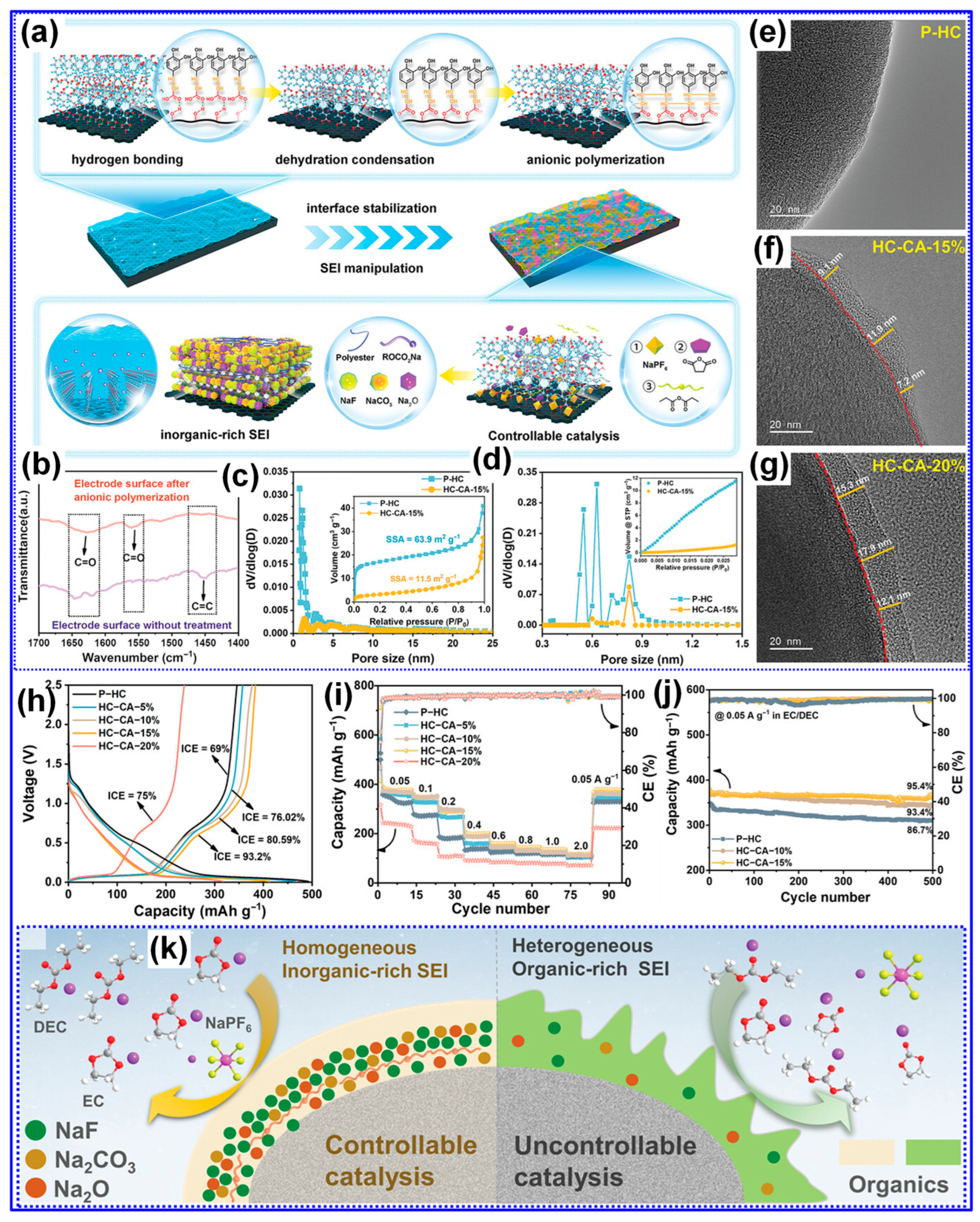

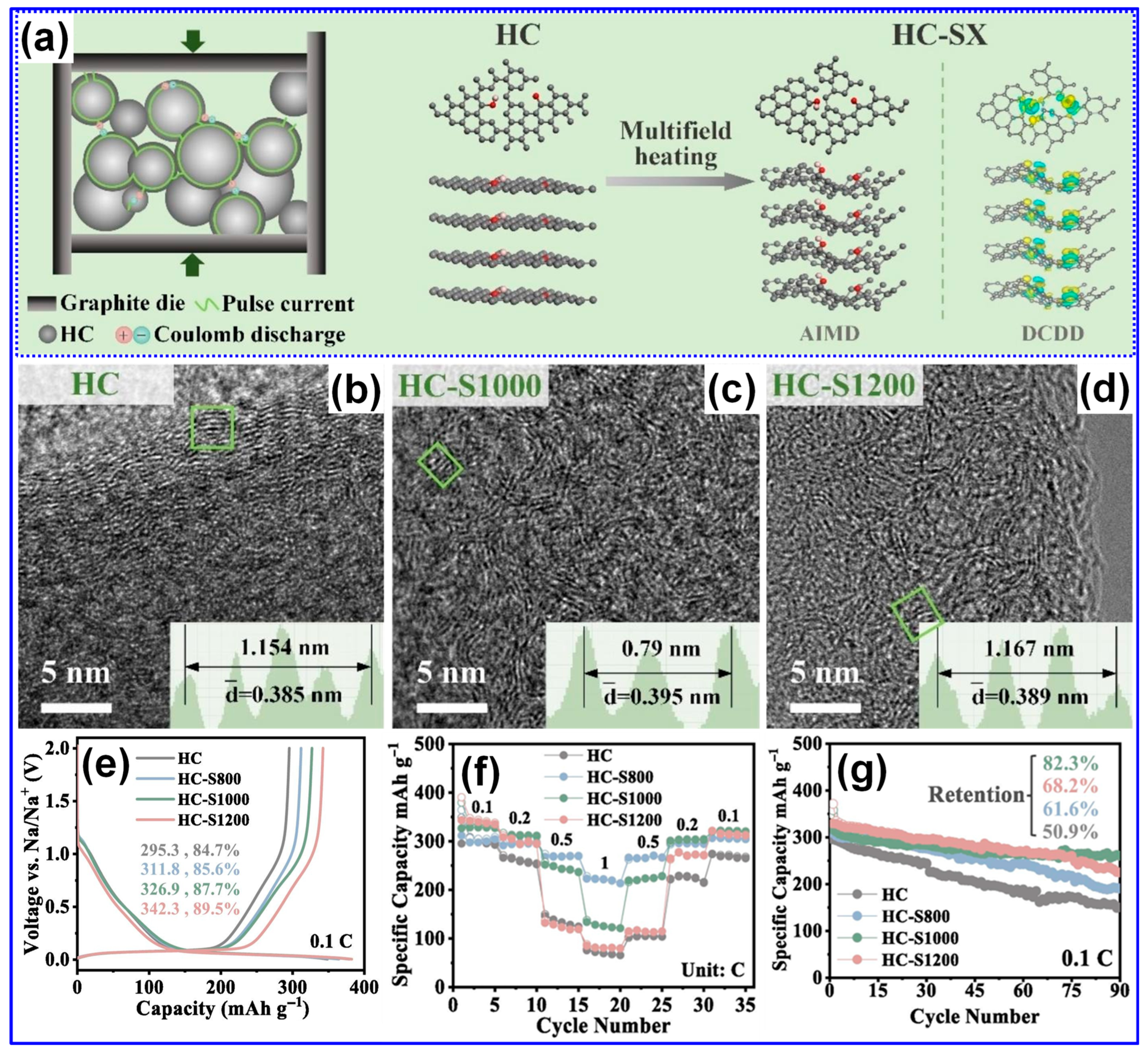

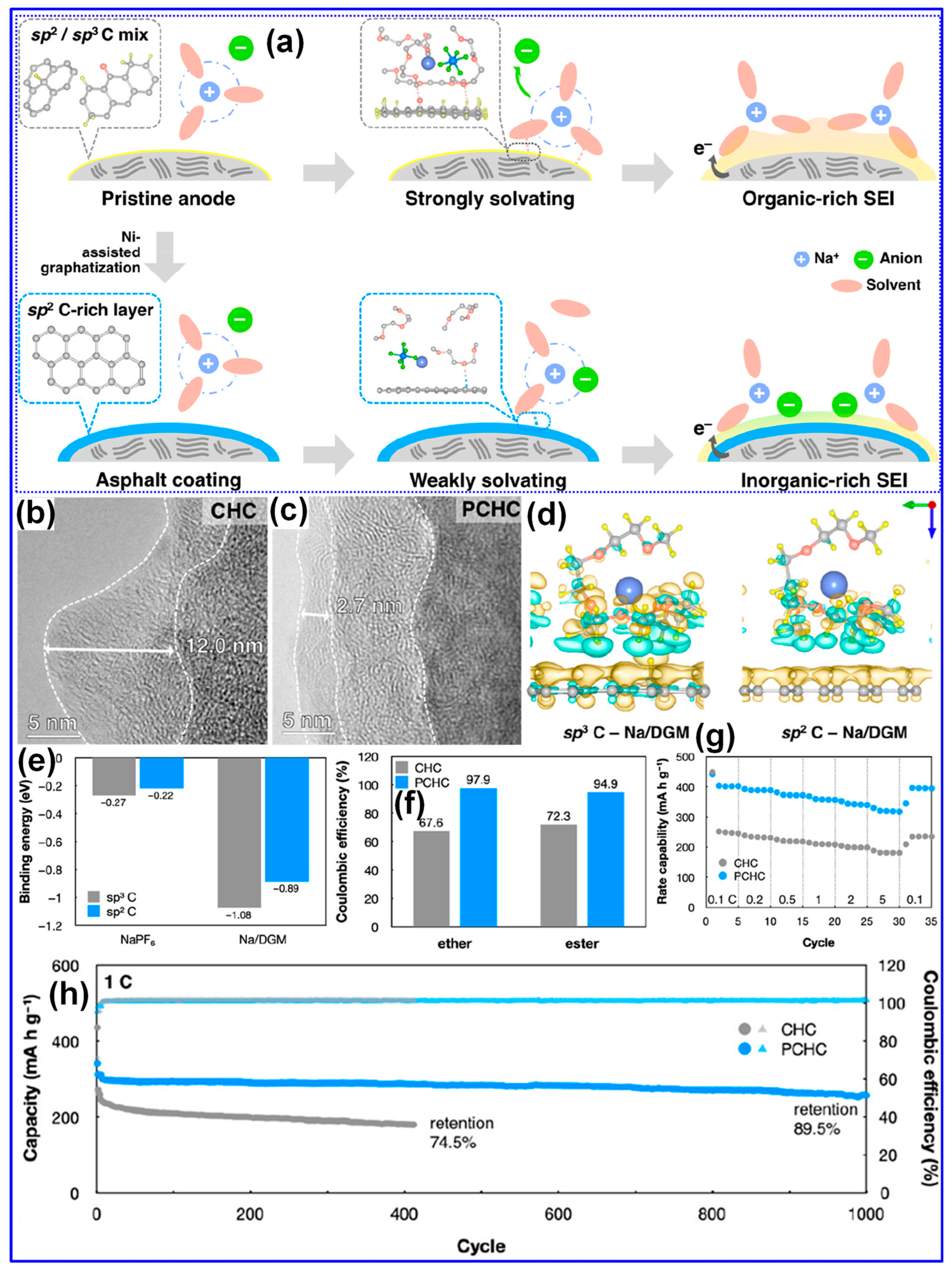
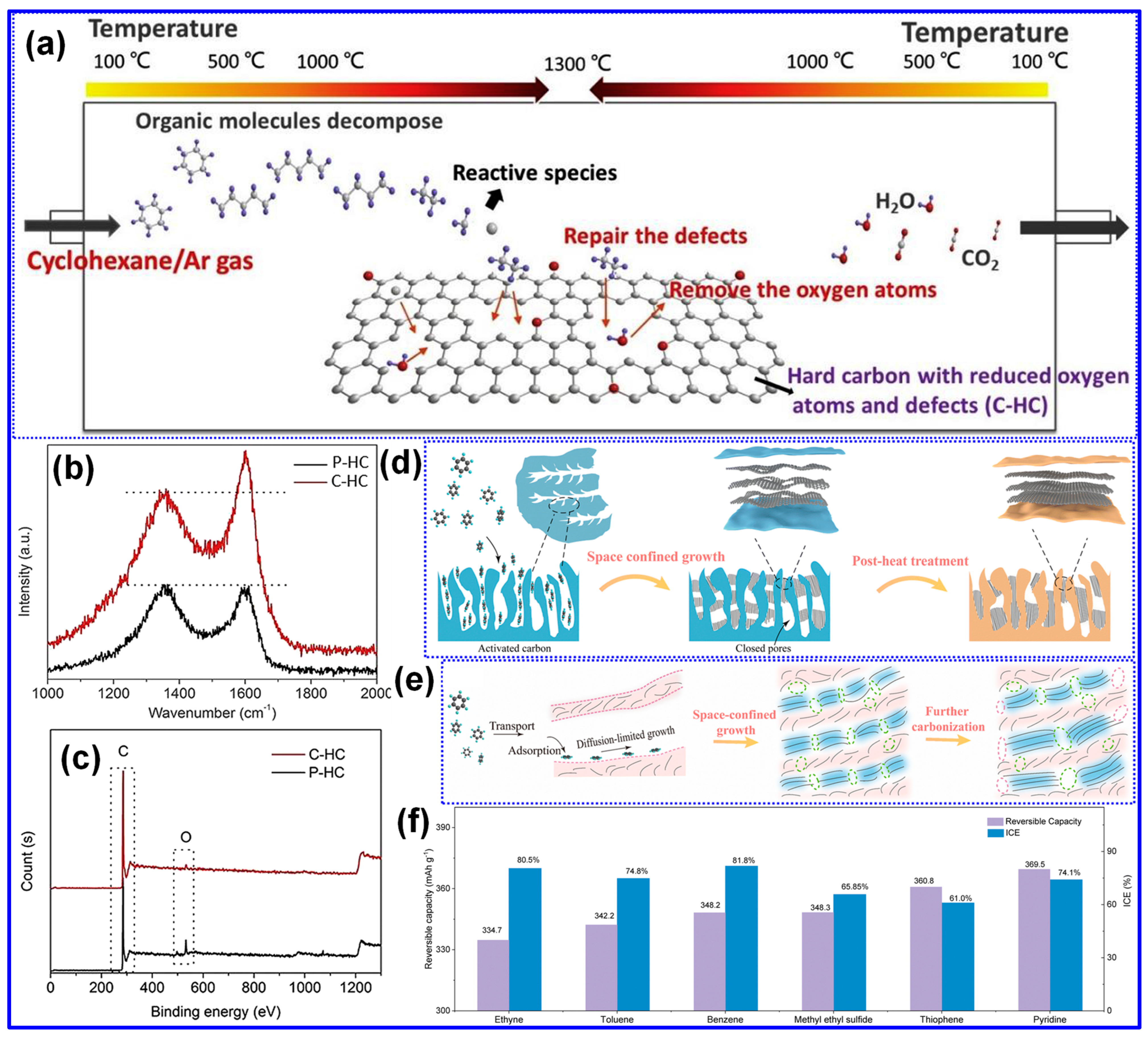
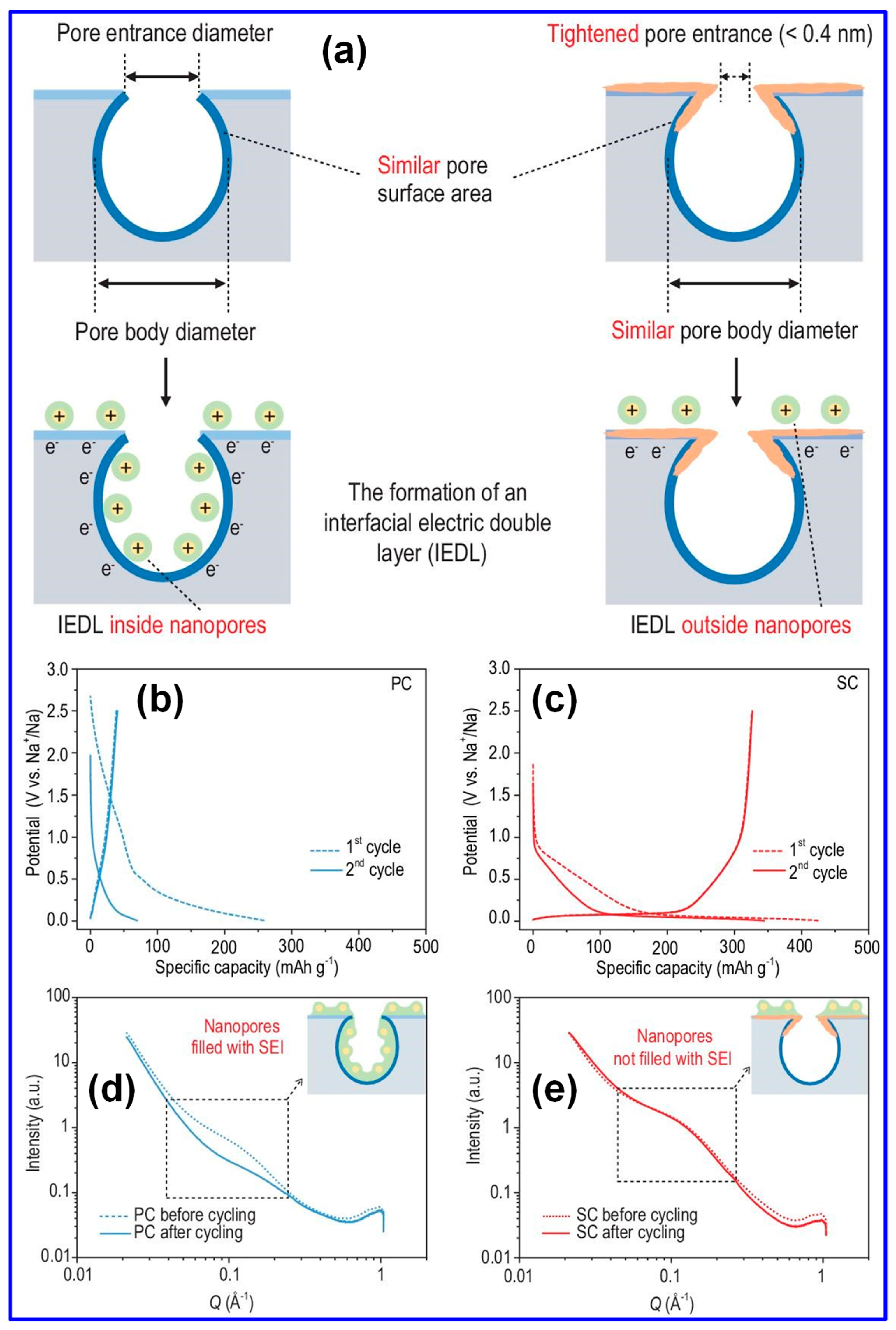
| Feedstocks | Cost ($/t) | C Yield (%) | Modifiability | Availability | Performance of Derived HCs | |
|---|---|---|---|---|---|---|
| Pitch | 300 | >50 | Difficult | Abundant | Poor | |
| Anthracite | 50–200 | ∼90 | ||||
| Lignocellulose biomass | Cellulose | 1000 | <10 | Normal | Good | |
| Lignin | 300 | >40 | Easy | |||
| Starch | 500 | <10 | Normal | _ 1 | ||
| Sucrose | 400 | _ 1 | ||||
| Coconut shell | 650 2 | ∼25 | Insufficient | |||
| Phenolic resin | 2000 | >40 | Easy | Abundant | Excellent |
| Classifications | Annual Production (t) | Ash Contents (%) | MW (g mol−1) | Polydispersity | Solubility |
|---|---|---|---|---|---|
| Lignosulfonate | >1,000,000 | 4–8 | 1000–61,000 | 6–8 | Water of wide pH |
| Organosolv lignin | Pilot scale | <1.5 | 500–5000 | 1.5–4.4 | Organic solvents, Alkali solutions |
| Klason lignin | Lab scale | 1–3 | 2000–7000 | 1.5–7.2 | Alkali solutions |
| Kraft lignin | >55,000,000 | 1000–5000 | 2.5–3.5 | Alkali solutions, polar organic solvents | |
| Soda lignin | >6000 | <2.8 | 0.8–3000 | Alkali solutions | |
| Steam explosion lignin | Lab scale | <4 | 1000–15,000 | 2.5–7 | |
| Enzymatic lignin | Pilot scale | 1–3 | 2000–9500 | 1.5–3.2 |
| Variable Factors | Horizontal Factors | Carbonization Conditions | Sodium Storage Performances | Structural Information | Ref. | ||||
|---|---|---|---|---|---|---|---|---|---|
| Capacity (mAh g−1) & Current Density (Cd, A g−1) | ICE (%) | Cycling Stability | Graphitic Domains | Defects | Pv (cm3 g−1) & SBET (m2 g−1) | ||||
| Lignin types (Different molecular weights (MWs) | Low | Heating rate: 5 °C min−1; Annealing time: 2 h; Carbonization temperature: 700 °C | - | - | - | d002 = 3.96; La = 1.20 nm | - | SBET = 6.1 | [104] |
| Middle | d002 = 4.04; La = 1.24 nm | SBET = 12.3 | |||||||
| High | d002 = 3.91; La = 1.25 nm | SBET = 0.71 | |||||||
| Lignin types (Different extraction methods) | Kraft lignin (LK) | Heating rate: 5 °C min−1; Annealing time: 1 h | C = 181 Cd = 0.025 | 66.4 | - | d002 = 3.842 | Id/Ig = 2.4 | b Pv = 0.04; SBET = 1.6 | [89] |
| Lignin sulphonates (LS) | Carbonization temperature: 1200 °C | C = 205 Cd = 0.025 | 64.3 | - | d002 = 3.827 | b Pv = 0.16; SBET = 180 | |||
| Lignin sulphonates (LSW) | Heating rate: 5 °C min−1; Annealing time: 1 h; c Carbonization temperature: 600 and 1200 °C | C = 284 Cd = 0.025 | 79.1 | Capacity retention is 95.1% after 50 cycles at 0.1 C | d002 = 3.797 | b Pv = 0.24; SBET = 5.6 | |||
| Lignin types (Different molecular weights, oxygenated functional groups, and polarities) | Low MW, high polarity and high carboxyl, phenolic hydroxyl contents | Heating rate: 5 °C min−1; Annealing time: 6 h; Carbonization temperature: 1300 °C | C = 268; Cd = 0.05 | 59.5 | Capacity retention is 82.9% after 100 cycles at 0.1 A g−1 | d002 = 0.399 nm; La = 4.57 nm; Lc = 0.85 nm | Id/Ig = 3.49 | a Pv = 0.0932 SBET = 117.17 | [105] |
| Middle MW, middle polarity and high alcohol hydroxyl contents | - | C = 314; Cd = 0.05 | 66.6 | Capacity retention is 78.2% after 100 cycles at 0.1 A g−1 | d002 = 0.406 nm; La = 4.74 nm; Lc = 0.88 nm | Id/Ig = 3.26 | a Pv = 0.158 SBET = 185.42 | ||
| High MW, low polarity and low oxygen contents | - | C = 312; Cd = 0.05 | 66.2 | Capacity retention is 89.4% after 100 cycles at 0.1 A g−1 | d002 = 0.390 nm; La = 4.27 nm; Lc = 0.95 nm | Id/Ig = 3.29 | a Pv = 0.1186 SBET = 182 | ||
| Lignin types (Different ash contents) | 6.4 wt% | Heating rate:5 °C min−1; Annealing time: 6 h; Carbonization temperature: 1300 °C | - | 45 | - | d002 = 0.377; La = 3.65; Lc = 0.84 | Id/Ig = 1.75 | Pv = 0.167; SBET = 278.4 | [106] |
| 1.1 wt% | C = 317; Cd = 0.05 | 87 | Capacity retention is 89.3% after 70 cycles at 0.05 A g−1 | d002 = 0.379; La = 4.47; Lc = 1.07 | Id/Ig = 1.56 | Pv = 0.081; SBET = 117.6 | |||
| f 1.1 wt% | - | 63 | - | d002 = 0.370; La = 3.81; Lc = 0.93 | Id/Ig = 1.64 | Pv = 0.027; SBET = 36.5 | |||
| 3.9 wt% | - | 45 | - | d002 = 0.383; La = 3.77; Lc = 0.94 | Id/Ig = 1.75 | Pv = 0.110; SBET = 175.3 | |||
| 1.7 wt% | - | 42 | - | d002 = 0.377; La = 3.61; Lc = 0.92 | Id/Ig = 1.79 | Pv = 0.103; SBET = 165 | |||
| e Morphologies | nano-spherical particles (LS) | Heating rate:5 °C min−1; Annealing time: 2 h; Carbonization temperature: 800 °C | C = 281.9; Cd = 0.1 | 50.34 | Capacity retention is 49% after 100 cycles at 0.1 A g−1 | d002 = 0.36; | Id/Ig = 0.7 | SBET = 40 | [107] |
| Carbon nanospheres (CNS) | C = 120.8; Cd = 0.1 | 11.51 | Capacity retention is 68.6% after 100 cycles at 0.1 A g−1 | d002 = 0.377; | Id/Ig = 0.67 | SBET = 229 | |||
| Porous Carbon (LCS) | C = 162.1; Cd = 0.1 | 26.63 | Capacity retention is 80.8% after 100 cycles at 0.1 A g−1 | d002 = 0.387; | Id/Ig = 0.83 | SBET = 4937 | |||
| Carbon particles (LC) | C = 69.3; Cd = 0.1 | 32.34 | Capacity retention is 61.8% after 100 cycles at 0.1 A g−1 | - | Id/Ig = 0.71 | - | |||
| Carbonization temperatures (Unknown lignin type) | 1000 °C | Heating rate: 5 °C min−1; Annealing time: 6 h | C = 202.61; Cd = 0.05 | 61 | Capacity retention >99% after 700 cycles at 0.3 A g−1 | d002 = 0.383 nm; La = 3.95 nm; Lc = 0.98 nm | Id/Ig = 1.87 | Pv = 0.228; SBET = 124.9 | [42] |
| 1100 °C | C = 230.29; Cd = 0.05 | 63 | - | d002 = 0.382 nm; La = 4.08 nm; Lc = 0.99 nm | Id/Ig = 1.51 | Pv = 0.187; SBET = 92.1 | |||
| 1200 °C | C = 255.56; Cd = 0.05 | 65 | - | d002 = 0.376 nm; La = 4.13 nm; Lc = 1.05 nm | Id/Ig = 0.85 | Pv = 0.113; SBET = 54.9 | |||
| 1300 °C | C = 260.55; Cd = 0.05 | 69 | - | d002 = 0.375 nm; La = 4.17 nm; Lc = 1.13 nm | Id/Ig = 0.72 | Pv = 0.112; SBET = 48.3 | |||
| 1400 °C | C = 246.36; Cd = 0.05 | 71 | - | d002 = 0.374 nm; La = 4.20 nm; Lc = 1.14 nm | Id/Ig = 0.56 | Pv = 0.107; SBET = 29.5 | |||
| 1500 °C | C = 216.61; Cd = 0.05 | 72 | - | d002 = 0.365 nm; La =4.22 nm; Lc =1.21 nm | Id/Ig = 0.47 | Pv = 0.088; SBET = 14.7 | |||
| Carbonization temperatures (Milled wood lignin) | 1000 °C | Heating rate: 3 °C min−1; Annealing time: 2 h | C = 216.4; Cd = 0.02 | 72.3 | - | d002 = 0.41 nm; La = 3.25 nm; Lc = 0.96 nm | Id/Ig = 4.1 | SBET = 11.2 | [58] |
| 1200 °C | C = 281.6; Cd = 0.02 | 72.8 | - | d002 = 0.396 nm; La = 4.267 nm; Lc = 1.01 nm | Id/Ig = 3.7 | SBET = 19.7 | |||
| 1400 °C | C = 292.6; Cd = 0.02 | 80.1 | - | d002 = 0.392 nm; La = 4.34 nm; Lc = 1.16 nm | Id/Ig = 2.56 | SBET = 10.5 | |||
| 1600 °C | C = 290.7; Cd = 0.02 | 79.5 | - | d002 = 0.346 nm; La = 4.37 nm; Lc = 1.62 nm | Id/Ig = 2.38 | SBET = 10.3 | |||
| Carbonization temperatures (Softwood kraft lignin) | 800 °C | Step 1: Heating rate:3 °C min−1; Annealing time: 5 min; Carbonization temperature: 600 °C Step 2: Heating rate:5 °C min−1; Annealing time: 20 min; Carbonization temperature: 800~1700 °C | C = 150; Cd = 0.03 | 59 | - | d002 = 0.401 nm; La = 1.0 nm | - | SBET = 355 | [108] |
| 1000 °C | C = 260; Cd = 0.03 | 70 | - | d002 = 0.399 nm; La = 41.0 nm | - | SBET = 387 | |||
| 1200 °C | C = 310; Cd = 0.03 | 89 | - | d002 = 0.398 nm; La = 1.1 nm | - | SBET = 94 | |||
| 1700 °C | C = 280; Cd = 0.03 | 92 | - | d002 = 0.367 nm; La = 1.4 nm | - | SBET = 47 | |||
| Carbonization temperatures (Dealkalized lignin) | 1000 °C | Heating rate:5 °C min−1; Annealing time: 2 h | C = 231.7; Cd = 0.05 | 51.4 | As the temperature increases, the cycling stability increases synchronously | d002 = 0.386 nm; La = 1.74 nm | Id/Ig = 1.91 | SBET = 87.2 | [60] |
| 1200 °C | C = 279.8; Cd = 0.05 | 56.3 | d002 = 0.383 nm; La = 2.16 nm | Id/Ig = 1.71 | SBET = 56.8 | ||||
| 1400 °C | C = 284.7; Cd = 0.05 | 54.1 | d002 = 0.375 nm; La = 2.27 nm | Id/Ig = 1.58 | SBET = 33 | ||||
| 1600 °C | C = 307.2; Cd = 0.05 | 68.2 | d002 = 0.365 nm; La = 2.57 nm | Id/Ig = 1.49 | SBET = 35.9 | ||||
| 1800 °C | C = 215.1; Cd = 0.05 | 60.8 | d002 = 0.346 nm; La = 3.75 nm | Id/Ig = 1.41 | SBET = 45 | ||||
| Water content in the atmosphere (Kraft soft wood lignin) | 0 g m−3 | Heating rate:10 °C min−1; Annealing time: 1 h; Carbonization temperature: 1000 °C | - | - | - | La = 2.12 nm | - | Pv = 0.051; SBET = 31.76 | [109] |
| 18 g m−3 | Pv = 0.14; SBET = 54.2 | ||||||||
| 45 g m−3 | Pv = 0.116; SBET = 78.96 | ||||||||
| 75 g m−3 | La = 2.13 nm | Pv = 0.658; SBET = 112 | |||||||
| 105 g m−3 | La = 2.12 nm | Pv = 0.082; SBET = 105 | |||||||
| Carbonization atmosphere | N2 | Heating rate:13 °C min−1; Annealing time: 6 h; Carbonization temperature: 1000 °C | C = 260; Cd = 0.1 C | 81.8 | - | d002 = 0.40 nm; La = 2.9 nm; Lc = 0.8 nm | d Ad/Ag = 3.7 | SBET = 185 | [110] |
| Ar | C = 252; Cd = 0.1C | 80.5 | d002 = 0.40 nm; La = 2.9 nm; Lc = 0.8 nm | SBET = 21 | |||||
| Ar + 5% H2 | C = 128; Cd = 0.1 C | 47.4 | d002 = 0.40 nm; La = 3.0 nm; Lc = 0.8 nm | d Ad/Ag = 3.6 | SBET = 252 | ||||
| Heating rates (Camphor wood residues) | 5 °C min−1 | Annealing time: 2 h; Carbonization temperature: 1300 °C | C = 242.6; Cd = 0.02 | 60.8 | Capacity retention is 84.7% after 50 cycles at 0.02 A g−1 | d002 = 0.363 nm; La = 3.54 nm; Lc = 1.71 nm | Id/Ig = 1.63 | Pv = 0.068; SBET = 111.4 | [111] |
| 2 °C min−1 | C = 270.2; Cd = 0.02 | 67.5 | Capacity retention is 96.6% after 50 cycles at 0.02 A g−1 | d002 = 0.366 nm; La = 3.51 nm; Lc = 1.70 nm | Id/Ig = 1.56 | Pv = 0.065; SBET = 107.2 | |||
| 1 °C min−1 | C = 289.4; Cd = 0.02 | 76.4 | Capacity retention is 95.4% after 50 cycles at 0.02 A g−1 | d002 = 0.371 nm; La = 3.47 nm; Lc = 1.68 nm | Id/Ig = 1.55 | Pv = 0.017; SBET = 6.68 | |||
| 0.5 °C min−1 | C = 308.9; Cd = 0.02 | 80.4 | Capacity retention is 96.1% after 50 cycles at 0.02 A g−1 | d002 = 0.374 nm; La = 3.45 nm; Lc = 1.67 nm | Id/Ig = 1.5 | Pv = 0.018; SBET = 6.33 | |||
| 0.25 °C min−1 | C = 324.6; Cd = 0.02 | 82.8 | Capacity retention is 98.4% after 50 cycles at 0.02 A g−1 | d002 = 0.379 nm; La = 3.4 nm; Lc = 1.64 nm | Id/Ig = 1.48 | Pv = 0.015; SBET = 3.74 | |||
| None | Sodium lignin sulfonate | Step 1: Annealing time: 3 h; Carbonization temperature: 500 °C Step 2: Annealing time: 2 h; Carbonization temperature: 1300 °C | C = 339; Cd = 0.1 C | 88.3 | Capacity retention is 93% after 100 cycles at 0.1 C | d002 = 0.398 | Id/Ig = 1.07 | SBET = 11.89 | [112] |
| Lignin | Annealing time: 2 h; Carbonization temperature: 1200 °C | C = 203; Cd = 0.025 | 52.7 | Capacity retention is 57.4% after 300 cycles at 0.1 A g−1 | d002 = 0.38; La = 3.804; Lc = 0.592 | Id/Ig = 0.46 | SBET = 531.1 | [113] | |
| Byproduct of fuel alcohol production derived from corn stalks | Step 1: Annealing time: 1 h; Carbonization temperature: 400 °C Step 2: Annealing time: 3 h; Carbonization temperature: 1300 °C | C = 338.5; Cd = 0.025 | 76.7 | Capacity retention is 83.3% after 100 cycles at 0.05 A g−1 | d002 = 0.375; La = 2.82; Lc = 0.67 | Id/Ig = 1.077 | SBET = 6.78 | [114] | |
| Concentrated sulfuric acid hydrolysis lignin from oak wood | Heating rate: 10 °C min−1; Annealing time: 6 h; Carbonization temperature: 1300 °C | C = 297; Cd = 0.05 | 68% | Capacity retention is 99.8% after 500 cycles at 2.5 A g−1 | d002 = 0.403 nm; La = 3.44 nm; Lc = 0.9 nm | d Ad3/Ag = 0.8 | Pv = 0.04; SBET = 249.8 | [115] | |
Disclaimer/Publisher’s Note: The statements, opinions and data contained in all publications are solely those of the individual author(s) and contributor(s) and not of MDPI and/or the editor(s). MDPI and/or the editor(s) disclaim responsibility for any injury to people or property resulting from any ideas, methods, instructions or products referred to in the content. |
© 2025 by the authors. Licensee MDPI, Basel, Switzerland. This article is an open access article distributed under the terms and conditions of the Creative Commons Attribution (CC BY) license (https://creativecommons.org/licenses/by/4.0/).
Share and Cite
Kitchamsetti, N.; Mhin, S. Advances and Prospects of Lignin-Derived Hard Carbons for Next-Generation Sodium-Ion Batteries. Polymers 2025, 17, 2801. https://doi.org/10.3390/polym17202801
Kitchamsetti N, Mhin S. Advances and Prospects of Lignin-Derived Hard Carbons for Next-Generation Sodium-Ion Batteries. Polymers. 2025; 17(20):2801. https://doi.org/10.3390/polym17202801
Chicago/Turabian StyleKitchamsetti, Narasimharao, and Sungwook Mhin. 2025. "Advances and Prospects of Lignin-Derived Hard Carbons for Next-Generation Sodium-Ion Batteries" Polymers 17, no. 20: 2801. https://doi.org/10.3390/polym17202801
APA StyleKitchamsetti, N., & Mhin, S. (2025). Advances and Prospects of Lignin-Derived Hard Carbons for Next-Generation Sodium-Ion Batteries. Polymers, 17(20), 2801. https://doi.org/10.3390/polym17202801






